Powerwave Technologies 5JS0099 Wideband Radio Heads User Manual 044 05251 WRH V
Powerwave Technologies Inc Wideband Radio Heads 044 05251 WRH V
Users Manual
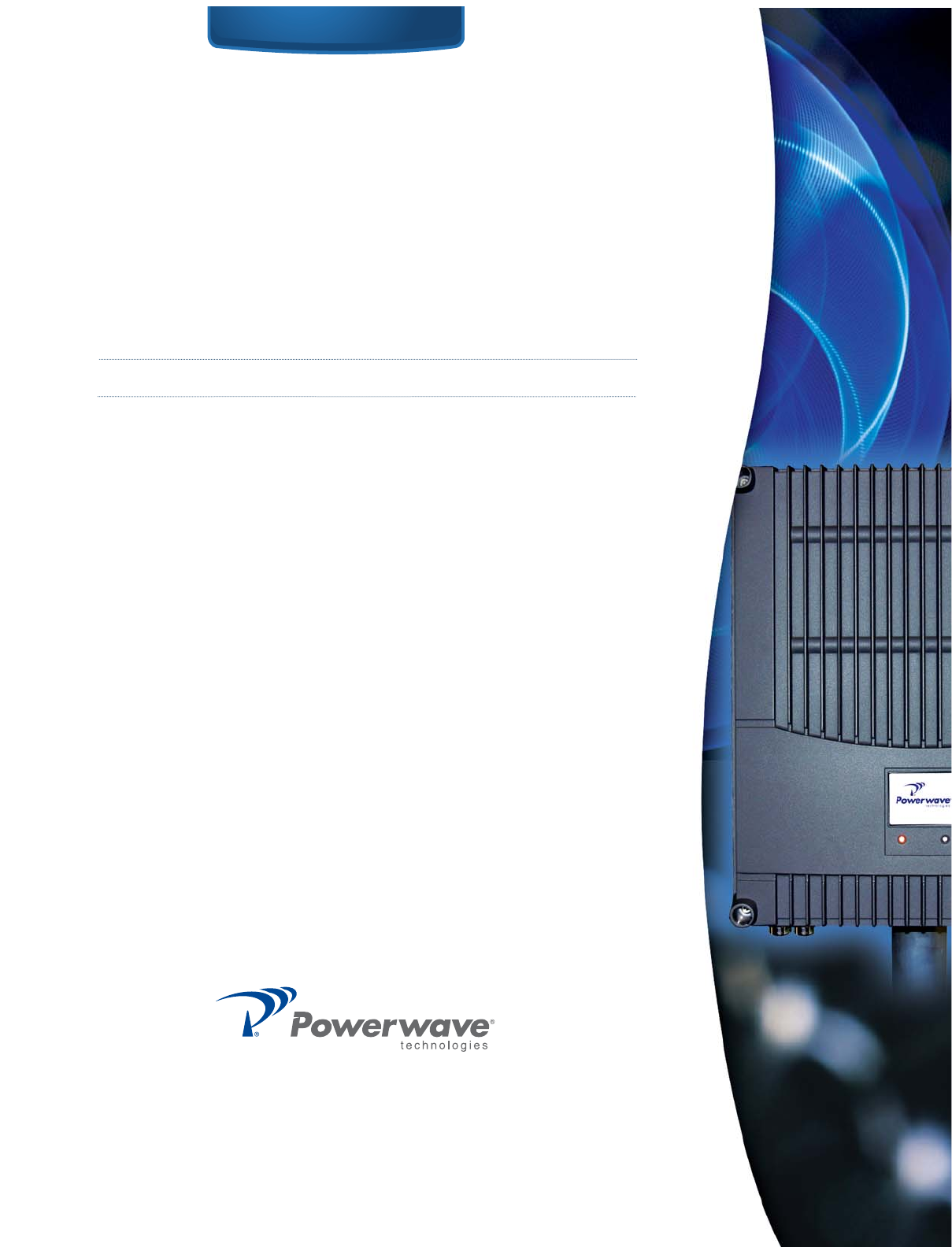
044-05251 Rev B January 2008
WIDEBAND RADIO HEAD
INSTALLATION AND SERVICE MANUAL
WRH
WIDEBAND RADIO HEAD
HIGH POWER VERSION

© 2007 Powerwave Technologies Incorporated. All rights reserved.
Powerwave Technologies and the Powerwave logo are registered trademarks.
Powerwave Technologies Inc. reserves the right to make changes to documentation and equipment, including
but not limited to component substitution and circuitry changes. Changes that impact this document may be
subsequently incorporated in a later revision of this document.
This Powerwave product is designed to operate within the Normal Operating (typical operating) ranges or con-
ditions specified in this document. Operation of this equipment beyond the specified ranges in this document
may cause (1) spurious emissions that violate regulatory requirements; (2) the equipment to be automatically
removed from service when maximum thresholds are exceeded; or (3) the equipment to not perform in accor-
dance with its specifications. It is the Operator's responsibility to ensure this equipment is properly installed and
operated within Powerwave operating specifications to obtain proper performance from the equipment and to
comply with regulatory requirements.
The rated output power of a WRH-V it is for multiple carriers. As long as the composite power does not exceed
the rated power (20W for North America), derating is not required for multiple carriers. For situations where
regulatory requirements require reduced interference to adjacent band users, the rating would have to be
reduced by 3 dB. This power reduction is to be by means of input power or gain reduction and not by an atten-
uator at the output of the device. Input power is rated at 115/230VAC, 50/60Hz, and should be protected based
on the power and fuse specifications in Chapter 5 of this manual. Power strips should, at a minimum, conform
to this requirement to prevent equipment damage and possible overload.
Federal Communications Commission (FCC)
This equipment has been tested and found to comply with the limits for a Class A digital device, pursuant to
CRF47 part 15 of the FCC rules. This equipment is also certified to CRF47 part 22 (cellular), part 24 (PCS) and
part 90 (iDEN800 and iDEN900) of the FCC Rules depending on the band of operation. Changes or modifica-
tions not expressly approved by Powerwave Technologies, Inc. for compliance could void the user’s authority
to operate this equipment. These limits are designed to provide reasonable protection against harmful interfer-
ence when the equipment is operated in a commercial environment. This equipment generates, uses, and can
radiate radio frequency energy and, if not installed and used in accordance with the instruction manual, may
cause harmful interference to radio communications. Operation of this equipment in a residential area is likely
to cause harmful interference in which case the user will be required to correct the interference at his own
expense.
Industry Canadian Requirements
All Powerwave apparatus introduced in the Canadian market meet all requirements of the Canadian Interfer-
ence-Causing Equipment Regulations. The -20dB bandwidth at 1900 MHz band is 80 MHz. The -20dB band-
width at IDEN 900 MHz band is 20 MHz. The -20dB bandwidth at the 850 MHz is 34 MHz. The output
impedance of the unit referenced in this document is 50 Ohms. The -20dB bandwidth at IDEN 800MHz band is
26 MHz. The Manufacturer's rated output power of this equipment is for single carrier operation. For situations
when multiple carrier signals are present, the rating would have to be reduced. For example, at IDEN 800MHz
band, the rating would have to be reduced by 3.5 dB, especially where the output signal is re-radiated and can
cause interference to adjacent band users. This power reduction is to be by means of input power or gain
reduction and not by an attenuator at the output of the device. The input signal is optical so input impedance
requirements are not applicable.
European Requirements
The Powerwave WRH-V apparatus introduced in EU markets are certified to ESTI EN 300 609-4 (GSM900 and
DCS1800) and ESTI EN 301 908-11 (WCDMA).
Powerwave Technologies Inc., 1801 East St. Andrew Place, CA 92705 Santa Ana, USA.
Phone +1 714 466 1000 – Fax +1 714 466 5800 – Internet www.powerwave.com

High Power Wideband Radio Head (WRH-V) Warnings, Cautions, and Notes
044-05251 Rev B i
Warnings, Cautions, and Notes
Warnings, Cautions, and Notes are found throughout this manual where applicable. The associated
icons in warnings and cautions are used to quickly identify a potential condition that could result in the
consequences described below if precautions are not taken. Notes clarify and provide additional
information to assist the user.
WARNING: The warning symbol means danger. You are in a situation that could cause
bodily injury or death. Before you work on any equipment, be aware of the hazards
involved with electrical and RF circuitry and be familiar with standard practices for
preventing accidents.
CAUTION: The caution symbol means the potential exists for equipment damage or loss
of data.
NOTE Notes contain helpful suggestions or references to material not covered in the document.
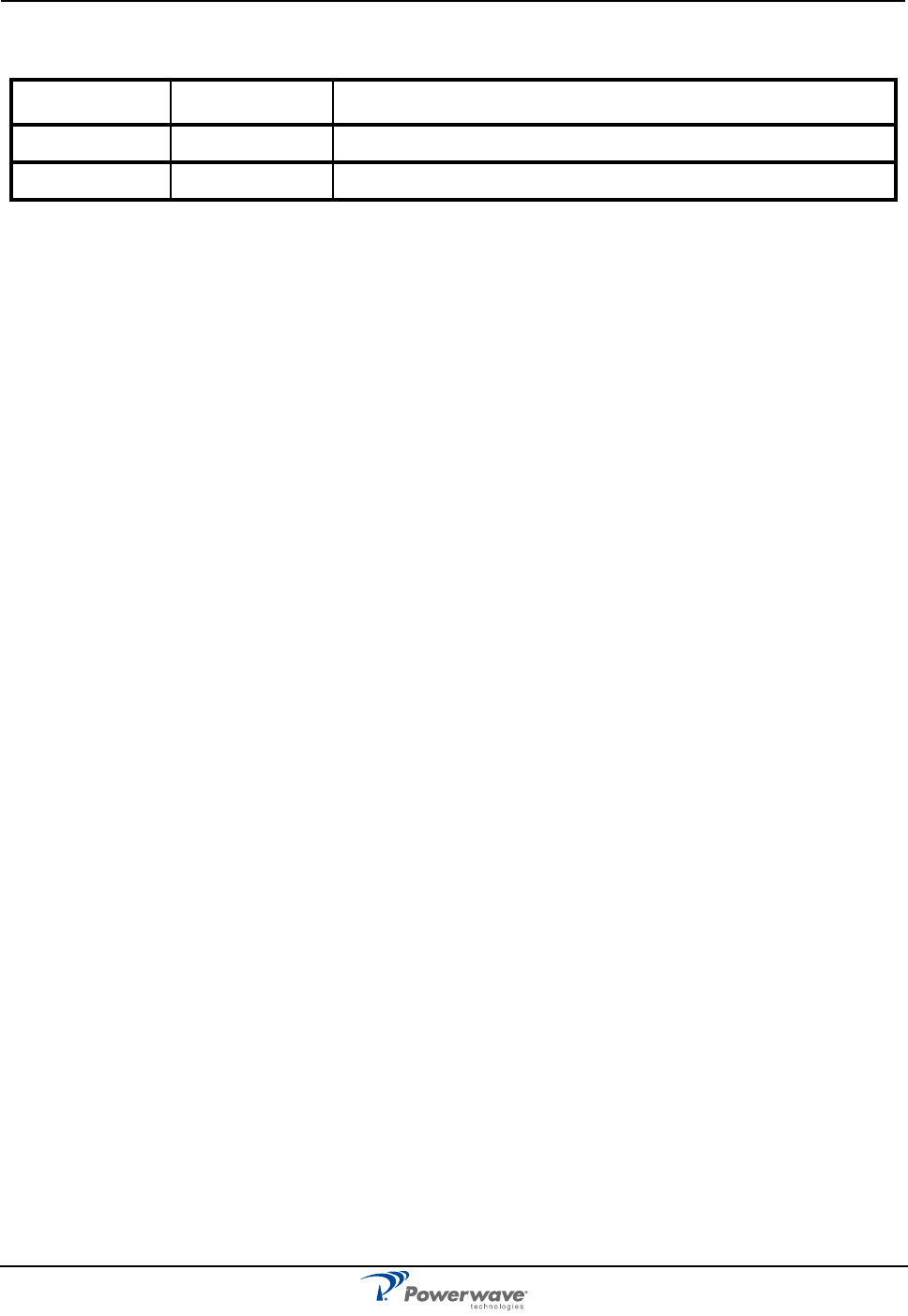
Revision Record High Power Wideband Radio Head (WRH-V)
ii 044-05251 Rev B
Revision Record
Revision Letter Date of Change Reason for Change
A November 2007 New (original)
B January 2008 Added laser safety information to pages 1-2, 3-5, 4-6, 5-2 and 5-3

044-05251 Rev Biii
Table of Contents
Chapter 1 - Product Description
Introduction . . . . . . . . . . . . . . . . . . . . . . . . . . . . . . . . . . . . . . . . . . . . . . . . . . . . . . . . . . . . . . . . . . . . . . . .1-1
Scope of Manual . . . . . . . . . . . . . . . . . . . . . . . . . . . . . . . . . . . . . . . . . . . . . . . . . . . . . . . . . . . . . . . . . . . .1-1
Safety . . . . . . . . . . . . . . . . . . . . . . . . . . . . . . . . . . . . . . . . . . . . . . . . . . . . . . . . . . . . . . . . . . . . . . . . . . . .1-1
Human Exposure of RF Radiation . . . . . . . . . . . . . . . . . . . . . . . . . . . . . . . . . . . . . . . . . . . . . . . . . . .1-2
Antennas . . . . . . . . . . . . . . . . . . . . . . . . . . . . . . . . . . . . . . . . . . . . . . . . . . . . . . . . . . . . . . . . . . .1-2
Installation and Maintenance of Antenna Systems. . . . . . . . . . . . . . . . . . . . . . . . . . . . . . . . . . . .1-2
Radiation Exposure . . . . . . . . . . . . . . . . . . . . . . . . . . . . . . . . . . . . . . . . . . . . . . . . . . . . . . . . . . .1-2
Electrostatic Discharge (ESD). . . . . . . . . . . . . . . . . . . . . . . . . . . . . . . . . . . . . . . . . . . . . . . . . . . . . . .1-3
Overview . . . . . . . . . . . . . . . . . . . . . . . . . . . . . . . . . . . . . . . . . . . . . . . . . . . . . . . . . . . . . . . . . . . . . . . . . .1-3
Chassis Design . . . . . . . . . . . . . . . . . . . . . . . . . . . . . . . . . . . . . . . . . . . . . . . . . . . . . . . . . . . . . . . . . .1-4
Sub Unit Overview . . . . . . . . . . . . . . . . . . . . . . . . . . . . . . . . . . . . . . . . . . . . . . . . . . . . . . . . . . . . . . .1-4
Wideband Amplifier PCBA (WBA) . . . . . . . . . . . . . . . . . . . . . . . . . . . . . . . . . . . . . . . . . . . . . . . .1-4
Multi-Carrier Power Amplifier PCBA (MCPA) . . . . . . . . . . . . . . . . . . . . . . . . . . . . . . . . . . . . . . . .1-4
Distribution PCBA (DIA) . . . . . . . . . . . . . . . . . . . . . . . . . . . . . . . . . . . . . . . . . . . . . . . . . . . . . . . .1-4
Control Unit PCBA (CU) . . . . . . . . . . . . . . . . . . . . . . . . . . . . . . . . . . . . . . . . . . . . . . . . . . . . . . . .1-5
Low Noise Amplifier (LNA) . . . . . . . . . . . . . . . . . . . . . . . . . . . . . . . . . . . . . . . . . . . . . . . . . . . . . .1-5
Duplex Filter (DPX). . . . . . . . . . . . . . . . . . . . . . . . . . . . . . . . . . . . . . . . . . . . . . . . . . . . . . . . . . . .1-5
Fiber Optic Unit (FOU) . . . . . . . . . . . . . . . . . . . . . . . . . . . . . . . . . . . . . . . . . . . . . . . . . . . . . . . . .1-6
Fiber Optic Node (FON) . . . . . . . . . . . . . . . . . . . . . . . . . . . . . . . . . . . . . . . . . . . . . . . . . . . . . . . .1-6
Power Supply Unit (PSU) . . . . . . . . . . . . . . . . . . . . . . . . . . . . . . . . . . . . . . . . . . . . . . . . . . . . . . .1-6
Remote Control Unit (RCU) . . . . . . . . . . . . . . . . . . . . . . . . . . . . . . . . . . . . . . . . . . . . . . . . . . . . .1-6
Alarm Interface PCBA (ALI) and Remote Control Interface PCBA (RCI) . . . . . . . . . . . . . . . . . . .1-6
Sub Unit Locations . . . . . . . . . . . . . . . . . . . . . . . . . . . . . . . . . . . . . . . . . . . . . . . . . . . . . . . . . . . . . . .1-6
Fiber Optic Distribution Networks . . . . . . . . . . . . . . . . . . . . . . . . . . . . . . . . . . . . . . . . . . . . . . . . . . . .1-7
Multi-Operator Configurations . . . . . . . . . . . . . . . . . . . . . . . . . . . . . . . . . . . . . . . . . . . . . . . . . . . . . .1-8
Chapter 2 - Controls, Indicators and Connectors
Introduction . . . . . . . . . . . . . . . . . . . . . . . . . . . . . . . . . . . . . . . . . . . . . . . . . . . . . . . . . . . . . . . . . . . . . . . .2-1
Front Cover Indicators . . . . . . . . . . . . . . . . . . . . . . . . . . . . . . . . . . . . . . . . . . . . . . . . . . . . . . . . . . . . . . . .2-1
Cabinet Indicators . . . . . . . . . . . . . . . . . . . . . . . . . . . . . . . . . . . . . . . . . . . . . . . . . . . . . . . . . . . . . . . . . . .2-1
PCBA Indicators . . . . . . . . . . . . . . . . . . . . . . . . . . . . . . . . . . . . . . . . . . . . . . . . . . . . . . . . . . . . . . . . . . . .2-2
CU PCBA . . . . . . . . . . . . . . . . . . . . . . . . . . . . . . . . . . . . . . . . . . . . . . . . . . . . . . . . . . . . . . . . . . . . . .2-2
FON PCBA . . . . . . . . . . . . . . . . . . . . . . . . . . . . . . . . . . . . . . . . . . . . . . . . . . . . . . . . . . . . . . . . . . . . .2-3
PCBA Connections . . . . . . . . . . . . . . . . . . . . . . . . . . . . . . . . . . . . . . . . . . . . . . . . . . . . . . . . . . . . . . . . . .2-3
DIA PCBA . . . . . . . . . . . . . . . . . . . . . . . . . . . . . . . . . . . . . . . . . . . . . . . . . . . . . . . . . . . . . . . . . . . . .2-4
LNA . . . . . . . . . . . . . . . . . . . . . . . . . . . . . . . . . . . . . . . . . . . . . . . . . . . . . . . . . . . . . . . . . . . . . . . . . .2-5
FON . . . . . . . . . . . . . . . . . . . . . . . . . . . . . . . . . . . . . . . . . . . . . . . . . . . . . . . . . . . . . . . . . . . . . . . . . .2-6
PSU . . . . . . . . . . . . . . . . . . . . . . . . . . . . . . . . . . . . . . . . . . . . . . . . . . . . . . . . . . . . . . . . . . . . . . . . . .2-7
Software and Hardware Compatibility . . . . . . . . . . . . . . . . . . . . . . . . . . . . . . . . . . . . . . . . . . . . . . . . . . . .2-8
Chapter 3 - Installation
Introduction . . . . . . . . . . . . . . . . . . . . . . . . . . . . . . . . . . . . . . . . . . . . . . . . . . . . . . . . . . . . . . . . . . . . . . . .3-1
Site Survey . . . . . . . . . . . . . . . . . . . . . . . . . . . . . . . . . . . . . . . . . . . . . . . . . . . . . . . . . . . . . . . . . . . . . . . .3-1
Unpacking and Inspection . . . . . . . . . . . . . . . . . . . . . . . . . . . . . . . . . . . . . . . . . . . . . . . . . . . . . . . . . . . . .3-1
WRH-V Location . . . . . . . . . . . . . . . . . . . . . . . . . . . . . . . . . . . . . . . . . . . . . . . . . . . . . . . . . . . . . . . . . . . .3-1
Mounting . . . . . . . . . . . . . . . . . . . . . . . . . . . . . . . . . . . . . . . . . . . . . . . . . . . . . . . . . . . . . . . . . . . . . . . . . .3-1
Connections. . . . . . . . . . . . . . . . . . . . . . . . . . . . . . . . . . . . . . . . . . . . . . . . . . . . . . . . . . . . . . . . . . . . . . . .3-4
Main Power and Grounding . . . . . . . . . . . . . . . . . . . . . . . . . . . . . . . . . . . . . . . . . . . . . . . . . . . . . . . .3-4

Table of Contents High Power Wideband Radio Head (WRH-V)
iv 044-05251 Rev B
Fiber Optic and RF Connections. . . . . . . . . . . . . . . . . . . . . . . . . . . . . . . . . . . . . . . . . . . . . . . . . . . . .3-4
WRH-V . . . . . . . . . . . . . . . . . . . . . . . . . . . . . . . . . . . . . . . . . . . . . . . . . . . . . . . . . . . . . . . . . . . . .3-5
Optional Connections . . . . . . . . . . . . . . . . . . . . . . . . . . . . . . . . . . . . . . . . . . . . . . . . . . . . . . . . . . . . . . . .3-6
Alarms . . . . . . . . . . . . . . . . . . . . . . . . . . . . . . . . . . . . . . . . . . . . . . . . . . . . . . . . . . . . . . . . . . . . . . . . .3-6
External Alarm. . . . . . . . . . . . . . . . . . . . . . . . . . . . . . . . . . . . . . . . . . . . . . . . . . . . . . . . . . . . . . . . . . .3-6
Door Open Alarm . . . . . . . . . . . . . . . . . . . . . . . . . . . . . . . . . . . . . . . . . . . . . . . . . . . . . . . . . . . . . . . .3-6
Main Power Breakdown Relay . . . . . . . . . . . . . . . . . . . . . . . . . . . . . . . . . . . . . . . . . . . . . . . . . . . . . .3-6
21-60 Volt DC PSU Installation . . . . . . . . . . . . . . . . . . . . . . . . . . . . . . . . . . . . . . . . . . . . . . . . . . . . . .3-7
Commissioning . . . . . . . . . . . . . . . . . . . . . . . . . . . . . . . . . . . . . . . . . . . . . . . . . . . . . . . . . . . . . . . . . . . . .3-7
Initial Startup . . . . . . . . . . . . . . . . . . . . . . . . . . . . . . . . . . . . . . . . . . . . . . . . . . . . . . . . . . . . . . . . . . . .3-8
Passive Intermodulation (PIM) Testing . . . . . . . . . . . . . . . . . . . . . . . . . . . . . . . . . . . . . . . . . . . . . . . .3-9
Chapter 4 - Maintenance
Introduction . . . . . . . . . . . . . . . . . . . . . . . . . . . . . . . . . . . . . . . . . . . . . . . . . . . . . . . . . . . . . . . . . . . . . . . .4-1
Periodic Maintenance . . . . . . . . . . . . . . . . . . . . . . . . . . . . . . . . . . . . . . . . . . . . . . . . . . . . . . . . . . . . . . . .4-1
Troubleshooting. . . . . . . . . . . . . . . . . . . . . . . . . . . . . . . . . . . . . . . . . . . . . . . . . . . . . . . . . . . . . . . . . . . . .4-1
Clearing Alarm Faults . . . . . . . . . . . . . . . . . . . . . . . . . . . . . . . . . . . . . . . . . . . . . . . . . . . . . . . . . . . . .4-1
Field Replaceable Units. . . . . . . . . . . . . . . . . . . . . . . . . . . . . . . . . . . . . . . . . . . . . . . . . . . . . . . . . . . . . . .4-6
FON. . . . . . . . . . . . . . . . . . . . . . . . . . . . . . . . . . . . . . . . . . . . . . . . . . . . . . . . . . . . . . . . . . . . . . . . . . .4-6
PSU. . . . . . . . . . . . . . . . . . . . . . . . . . . . . . . . . . . . . . . . . . . . . . . . . . . . . . . . . . . . . . . . . . . . . . . . . . .4-7
WRH-V . . . . . . . . . . . . . . . . . . . . . . . . . . . . . . . . . . . . . . . . . . . . . . . . . . . . . . . . . . . . . . . . . . . . . . . .4-8
Remote Control Unit (RCU) . . . . . . . . . . . . . . . . . . . . . . . . . . . . . . . . . . . . . . . . . . . . . . . . . . . . . . . . . . . .4-8
RCU for Radio Communication. . . . . . . . . . . . . . . . . . . . . . . . . . . . . . . . . . . . . . . . . . . . . . . . . . . . . .4-9
RCU for Telephone Line Communication . . . . . . . . . . . . . . . . . . . . . . . . . . . . . . . . . . . . . . . . . . . . . .4-9
Return For Service Procedures . . . . . . . . . . . . . . . . . . . . . . . . . . . . . . . . . . . . . . . . . . . . . . . . . . . . . . . . .4-9
Obtaining an RMA. . . . . . . . . . . . . . . . . . . . . . . . . . . . . . . . . . . . . . . . . . . . . . . . . . . . . . . . . . . . . . . .4-9
Repackaging for Shipment . . . . . . . . . . . . . . . . . . . . . . . . . . . . . . . . . . . . . . . . . . . . . . . . . . . . . . . . .4-9
Chapter 5 - Specifications
Introduction . . . . . . . . . . . . . . . . . . . . . . . . . . . . . . . . . . . . . . . . . . . . . . . . . . . . . . . . . . . . . . . . . . . . . . . .5-1
Appendix A - Block Diagrams
Introduction . . . . . . . . . . . . . . . . . . . . . . . . . . . . . . . . . . . . . . . . . . . . . . . . . . . . . . . . . . . . . . . . . . . . . . . .6-1
Non-Diversity . . . . . . . . . . . . . . . . . . . . . . . . . . . . . . . . . . . . . . . . . . . . . . . . . . . . . . . . . . . . . . . . . . . . . . .6-1
Diversity. . . . . . . . . . . . . . . . . . . . . . . . . . . . . . . . . . . . . . . . . . . . . . . . . . . . . . . . . . . . . . . . . . . . . . . . . . .6-2

High Power Wideband Radio Head (WRH-V) List of Figures
044-05251 Rev B v
List of Figures
Figure 1-1 Powerwave Wideband Radio Head (WRH) . . . . . . . . . . . . . . . . . . . . . . . . . . . . . . . . . . . . . .1-3
Figure 1-2 DIA PCBA . . . . . . . . . . . . . . . . . . . . . . . . . . . . . . . . . . . . . . . . . . . . . . . . . . . . . . . . . . . . . . . .1-4
Figure 1-3 CU PCBA . . . . . . . . . . . . . . . . . . . . . . . . . . . . . . . . . . . . . . . . . . . . . . . . . . . . . . . . . . . . . . . .1-5
Figure 1-4 LNA . . . . . . . . . . . . . . . . . . . . . . . . . . . . . . . . . . . . . . . . . . . . . . . . . . . . . . . . . . . . . . . . . . . . .1-5
Figure 1-5 FOU in WRH-V . . . . . . . . . . . . . . . . . . . . . . . . . . . . . . . . . . . . . . . . . . . . . . . . . . . . . . . . . . . .1-6
Figure 1-6 WRH-V Sub Unit Locations . . . . . . . . . . . . . . . . . . . . . . . . . . . . . . . . . . . . . . . . . . . . . . . . . . .1-7
Figure 1-7 Fiber Optic Star Configuration . . . . . . . . . . . . . . . . . . . . . . . . . . . . . . . . . . . . . . . . . . . . . . . . .1-7
Figure 1-8 Multi-operator System . . . . . . . . . . . . . . . . . . . . . . . . . . . . . . . . . . . . . . . . . . . . . . . . . . . . . . .1-8
Figure 2-1 External Indicators . . . . . . . . . . . . . . . . . . . . . . . . . . . . . . . . . . . . . . . . . . . . . . . . . . . . . . . . .2-1
Figure 2-2 Cabinet Internal Indicators . . . . . . . . . . . . . . . . . . . . . . . . . . . . . . . . . . . . . . . . . . . . . . . . . . .2-1
Figure 2-3 CU PCBA Indicators . . . . . . . . . . . . . . . . . . . . . . . . . . . . . . . . . . . . . . . . . . . . . . . . . . . . . . . .2-2
Figure 2-4 FON LED Indicators . . . . . . . . . . . . . . . . . . . . . . . . . . . . . . . . . . . . . . . . . . . . . . . . . . . . . . . .2-3
Figure 2-5 DIA PCBA Connectors and Testpoints . . . . . . . . . . . . . . . . . . . . . . . . . . . . . . . . . . . . . . . . . .2-4
Figure 2-6 LNA . . . . . . . . . . . . . . . . . . . . . . . . . . . . . . . . . . . . . . . . . . . . . . . . . . . . . . . . . . . . . . . . . . . . .2-6
Figure 2-7 FON Connector Locations . . . . . . . . . . . . . . . . . . . . . . . . . . . . . . . . . . . . . . . . . . . . . . . . . . . .2-6
Figure 2-8 PSU Location . . . . . . . . . . . . . . . . . . . . . . . . . . . . . . . . . . . . . . . . . . . . . . . . . . . . . . . . . . . . . 2-7
Figure 3-1 Mounting Bracket . . . . . . . . . . . . . . . . . . . . . . . . . . . . . . . . . . . . . . . . . . . . . . . . . . . . . . . . . .3-2
Figure 3-2 Mounting Bracket Installation on Wall . . . . . . . . . . . . . . . . . . . . . . . . . . . . . . . . . . . . . . . . . . .3-2
Figure 3-3 Attaching the Bracket to a Pole . . . . . . . . . . . . . . . . . . . . . . . . . . . . . . . . . . . . . . . . . . . . . . . .3-3
Figure 3-4 Attaching the Bracket to a Mast . . . . . . . . . . . . . . . . . . . . . . . . . . . . . . . . . . . . . . . . . . . . . . .3-3
Figure 3-5 Attaching the WRH-V to the Bracket . . . . . . . . . . . . . . . . . . . . . . . . . . . . . . . . . . . . . . . . . . . .3-4
Figure 3-6 WRH-V Cable Connections . . . . . . . . . . . . . . . . . . . . . . . . . . . . . . . . . . . . . . . . . . . . . . . . . . .3-5
Figure 3-7 External Alarm Connection . . . . . . . . . . . . . . . . . . . . . . . . . . . . . . . . . . . . . . . . . . . . . . . . . . .3-6
Figure 3-8 Main Power Breakdown Relay Connection . . . . . . . . . . . . . . . . . . . . . . . . . . . . . . . . . . . . . . .3-7
Figure 3-9 Connecting a PC for Local Access . . . . . . . . . . . . . . . . . . . . . . . . . . . . . . . . . . . . . . . . . . . . .3-8
Figure 3-10 PIM testing two carriers and one WRH-V . . . . . . . . . . . . . . . . . . . . . . . . . . . . . . . . . . . . . . .3-9
Figure 3-11 PIM testing one carrier over each of two WRH-Vs . . . . . . . . . . . . . . . . . . . . . . . . . . . . . . . .3-9
Figure 4-1 PSU Cable, Switch and Lable locations . . . . . . . . . . . . . . . . . . . . . . . . . . . . . . . . . . . . . . . . .4-6
Figure 4-2 RCU in the WRH-V cabinet . . . . . . . . . . . . . . . . . . . . . . . . . . . . . . . . . . . . . . . . . . . . . . . . . . .4-8
Figure A-1 WRH-V Block Diagram - Non-Diversity . . . . . . . . . . . . . . . . . . . . . . . . . . . . . . . . . . . . . . . . .6-1
Figure A-2 WRH-V Block Diagram - Diversity . . . . . . . . . . . . . . . . . . . . . . . . . . . . . . . . . . . . . . . . . . . . .6-2

List of Tables High Power Wideband Radio Head (WRH-V)
vi 044-05251 Rev B
List of Tables
Table 2-1 CU PCBA LED Indicators . . . . . . . . . . . . . . . . . . . . . . . . . . . . . . . . . . . . . . . . . . . . . . . . . . . . .2-2
Table 2-2 FON LED Indications . . . . . . . . . . . . . . . . . . . . . . . . . . . . . . . . . . . . . . . . . . . . . . . . . . . . . . . .2-3
Table 2-3 WRH-V Base Unit Connections . . . . . . . . . . . . . . . . . . . . . . . . . . . . . . . . . . . . . . . . . . . . . . . .2-4
Table 2-4 WRH-V Cover Unit Connections . . . . . . . . . . . . . . . . . . . . . . . . . . . . . . . . . . . . . . . . . . . . . . .2-4
Table 2-5 DIA PCBA Connections . . . . . . . . . . . . . . . . . . . . . . . . . . . . . . . . . . . . . . . . . . . . . . . . . . . . . .2-5
Table 2-6 LNA Connections . . . . . . . . . . . . . . . . . . . . . . . . . . . . . . . . . . . . . . . . . . . . . . . . . . . . . . . . . . .2-6
Table 2-7 FON Connectors . . . . . . . . . . . . . . . . . . . . . . . . . . . . . . . . . . . . . . . . . . . . . . . . . . . . . . . . . . .2-6
Table 2-8 Hardware / Software Compatibility . . . . . . . . . . . . . . . . . . . . . . . . . . . . . . . . . . . . . . . . . . . . . .2-8
Table 3-1 Cable Connection Procedure . . . . . . . . . . . . . . . . . . . . . . . . . . . . . . . . . . . . . . . . . . . . . . . . . .3-5
Table 3-2 Main Power Breakdown Relay Connection . . . . . . . . . . . . . . . . . . . . . . . . . . . . . . . . . . . . . . .3-7
Table 3-3 Initial Statup Procedure . . . . . . . . . . . . . . . . . . . . . . . . . . . . . . . . . . . . . . . . . . . . . . . . . . . . . .3-8
Table 3-4 PIM Testing Procedure . . . . . . . . . . . . . . . . . . . . . . . . . . . . . . . . . . . . . . . . . . . . . . . . . . . . . .3-10
Table 4-1 Recommended Periodic Maintenance . . . . . . . . . . . . . . . . . . . . . . . . . . . . . . . . . . . . . . . . . . .4-1
Table 4-2 Alarm Troubleshooting . . . . . . . . . . . . . . . . . . . . . . . . . . . . . . . . . . . . . . . . . . . . . . . . . . . . . . .4-1
Table 4-3 FON Replacement Procedure . . . . . . . . . . . . . . . . . . . . . . . . . . . . . . . . . . . . . . . . . . . . . . . . .4-6
Table 4-4 PSU Replacement Procedure . . . . . . . . . . . . . . . . . . . . . . . . . . . . . . . . . . . . . . . . . . . . . . . . .4-7
Table 4-5 WRH-V Replacement Procedure . . . . . . . . . . . . . . . . . . . . . . . . . . . . . . . . . . . . . . . . . . . . . . .4-8
Table 5-1 WRH-V Specifications . . . . . . . . . . . . . . . . . . . . . . . . . . . . . . . . . . . . . . . . . . . . . . . . . . . . . . .5-1

High Power Wideband Radio Head (WRH-V) Abbreviations
044-05251 Rev B vii
Abbreviations
The following list of abbreviations are used throughout this manual, the software, and the repeater:
AGC Automatic Gain Control
ALI Alarm Interface
AMPS Advanced Mobile Phone Service
BA Booster Amplifier
BeO Beryllium Oxide
BMU Base Station Master Unit
BS Base Station, BS antenna = towards the base station
BSA Band Selective Amplifier
BSel Band Selective
BTS Base Transceiver Station
CDMA Code Division Multiple Access
CHE Channel Amplifier for GSM and EDGE
CMB Combiner
CSA Channel Selective Amplifier
CSel Channel Selective
CU Control Unit
CW Continuous Wave
DAMPS Digital Advanced Mobile Phone Service
DC Directional Coupler
DCS Digital Communication System (same as PCN)
DIA Distribution Interface
DL Downlink signal direction (from base station via repeater to mobile station)
DPX Duplex filter
EDGE Enhanced Data rates for GSM Evolution
EEPROM Electrical Erasable Programmable Read Only Memory
EGSM Extended Global System for Mobile communication
ESD Electrostatic Discharge
ETACS Extended Total Access Communication System
ETSI European Telecommunications Standard Institute
FLI Fiber Link Interface
FON Fiber Optic Node
FOR Fiber Optic Repeater
FOU Fiber Optic Unit
GSM Global System for Mobile communication
HW Hardware
ICNIRP International Commission on Non-Ionizing Radiation Protection
LED Light Emitting Diode
LNA Low Noise Amplifier
MCPA Multi-Carrier Power Amplifier
MS Mobile Station, MS antenna = towards the mobile station

Abbreviations High Power Wideband Radio Head (WRH-V)
viii 044-05251 Rev B
MSC Mobile Switching Center
NEMA National Electrical Manufacturers Association
NiCd Nickel Cadmium
NMT Nordic Mobile Telephone system
NOC Network Operations Center
OCM Optical Converter Module
OMS Operation and Maintenance System
PCN Personal Communication Network (same as DCS)
PCS Personal Communication System
POI Point of Interconnect
PSM Power Supply Module
PTFE Polytetrafluoro Ethylene (Teflon)
R2R Repeater-to-Repeater
RCI Remote Control Interface
RCU Remote Control Unit
RCM RF Converter Module
RF Radio Frequency
RIA Repeater-to-Repeater Adapter
RMU Remote Master Unit
RSSI Received Signal Strength Indication
RTC Real Time Clock
SW Software
TACS Total Access Communication System
TDMA Time Division Multiple Access
UL Uplink signal direction (from mobile station via repeater to base station)
UPS Uninterruptible Power Supply
WHO World Health Organization
WLI Wire Link Interface
WRH Wideband Radio Head
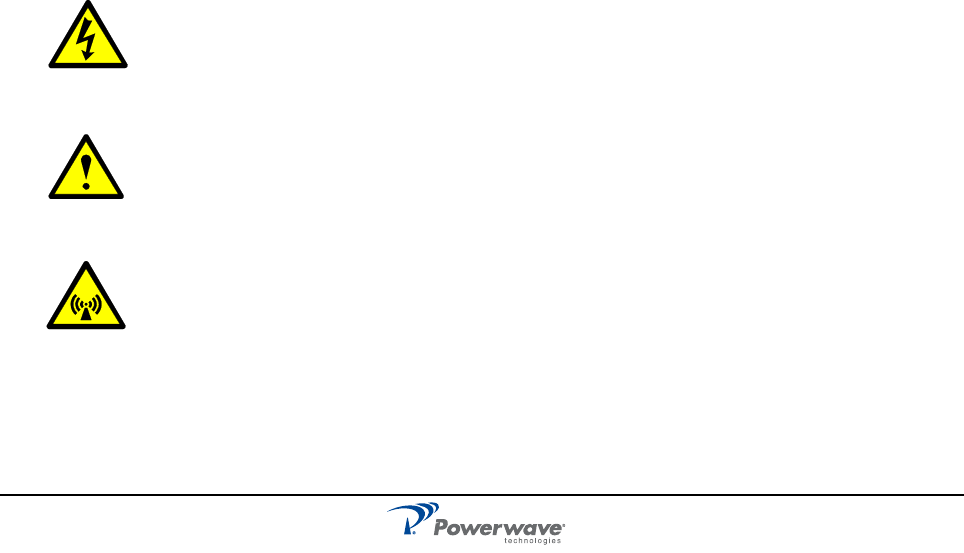
044-05251 Rev B 1-1
Chapter 1
Product Description
Introduction
This manual contains information and procedures for installation, operation, and maintenance of a High Power
Wideband Radio Head (WRH-V). The manual is organized into chapters as follows:
Scope of Manual
This manual is intended for use by service technicians familiar with similar types of equipment. It contains
service information required for the equipment described and is current as of the printing date. Changes which
occur after the printing date may be incorporated by a complete manual revision or alternatively as additions.
Safety
It is necessary that any personnel involved in installation, operation, or service of units included in a Powerwave
Distributed Antenna System (DAS) understand and follow the below points.
❑Powerwave WRH-Vs are designed to receive and amplify signals from one or more
base stations and retransmit the signals to one or more mobile stations. And, also to
act the other way round, that is to receive signals from one or more mobile stations,
amplify and retransmit the signals to the base stations. Powerwave WRH-V systems
must be used exclusively for this purpose and nothing else.
❑Units supplied from the mains must be connected to grounded outlets and in conformity
with the local prescriptions.
❑Power supply units supplied from the mains contain dangerous voltage that can cause
electric shock. Disconnect the mains prior to any work in such a unit. Local regulations
are to be followed when servicing such units. Authorized service personnel only are
allowed to service units while the mains is connected.
❑The WRH-V cover must be secured in opened position, for instance by tying it up.
Otherwise, the cover can be closed by the wind and cause your fingers getting pinched
or your head being hit.
❑When working on a WRH-V on high ground, for instance on a mast or pole, be careful
not to drop parts or the entire WRH. Falling parts can cause serious personal injury.
❑All RF transmitting units, including WRHs, will generate radio signals and thereby give
rise to electromagnetic fields that may be hazardous to the health of any person who is
extensively exposed close to an antenna.
❑A lithium battery is permanently mounted on the CU and FON PCBAs. Due to the risk
of explosion, this battery must only be removed from the board by a Powerwave
authorized service technician.
❑NiCd batteries are mounted on the FON PCBA. These batteries contain environmental
poisonous substances. If replaced, the old batteries should be disposed of as stated in
the local prescriptions.
❑Chapter 1 - Product Description
❑Chapter 2 - Controls and Indicators
❑Chapter 3 - Installation
❑Chapter 4 - Maintenance
❑Chapter 5 - Specifications
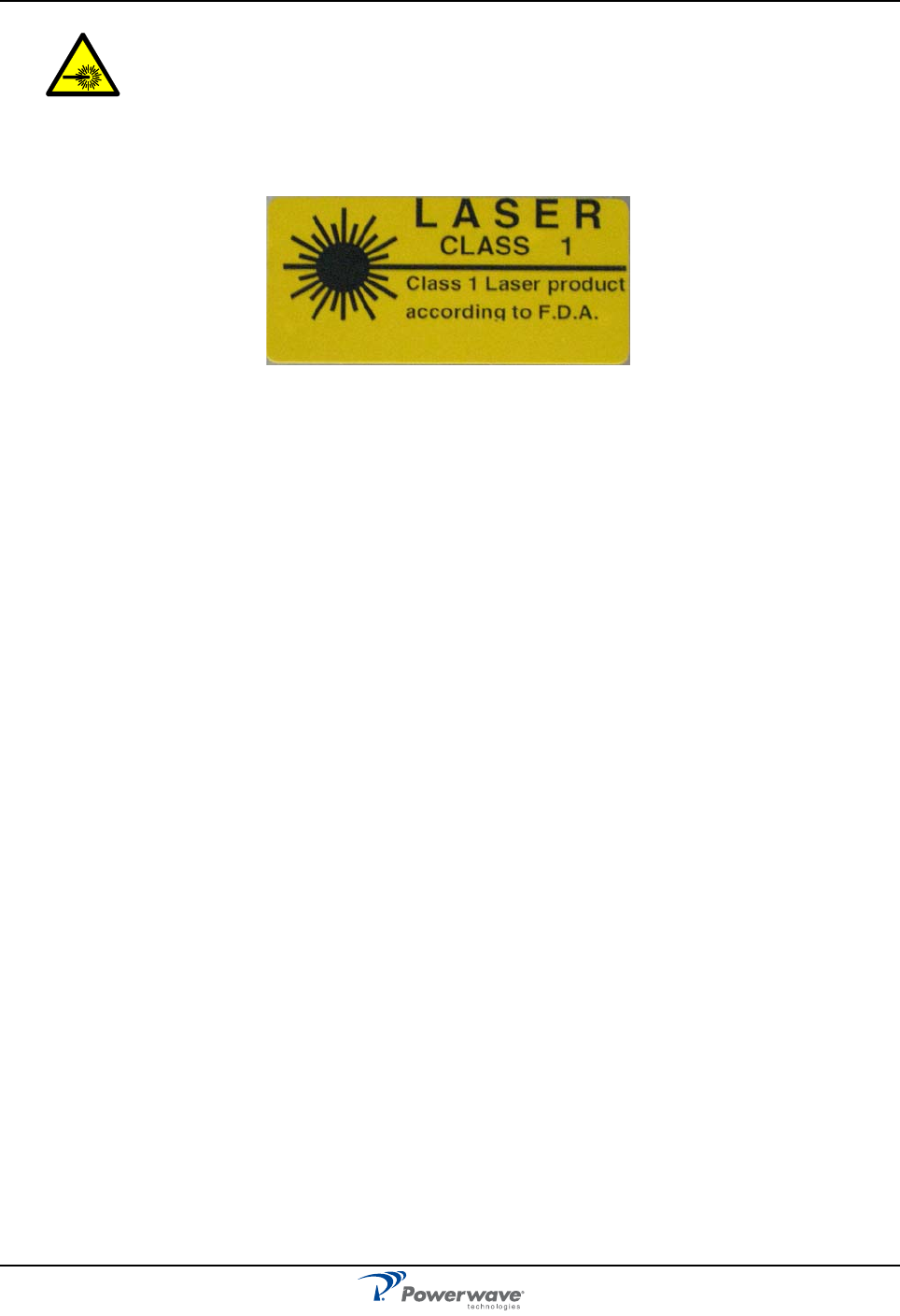
Safety High Power Wideband Radio Head (WRH-V)
1-2 044-05251 Rev B
❑The FON unit contains a Class 1M laser transmitter that emits 2—4 mW of invisible
laser radiation at 1550 nm during operation and is intended for a restricted location.
Avoid direct exposure from a disconnected laser transmitter or fiber cord. For example,
do not view directly with optical instruments (magnifiers) and do not view directly with
non-attenuating optical instruments.
❑The FON unit has this warning label attached:
❑See page 3-5, Fig. 3-6 for the location of laser apertures on the FON.
❑Do not power up the FON unit if a fiber cable is not connected to the fiber output UL
port, or if a fiber cable is connected to the port but disconnected at the other end.
❑Never look at the end of a fiber cable. The 1310nm and 1550nm laser light is not
visible. Always use an instrument, such as a power meter, to detect signaling.
Human Exposure of RF Radiation
Safe distances must be kept when working around antennas. The following paragraphs describe the cautions
to be aware of during the installation and maintenance of antenna systems and how to calculate safety
distances needed for RF radiation at different antenna power and frequencies.
Antennas
To be able to receive and transmit signals, a WRH-V is connected to a donor antenna directed towards the
base station and a service antenna directed towards the coverage area. A fiber optic cable from the base
station might, however, be substituted for the donor antenna.
Installation and Maintenance of Antenna Systems
Installation and maintenance of all antenna systems must be performed with respect to the radiation exposure
limits for public areas. The antenna radiation level is affected by WRH-V output power, antenna gain, and
transmission devices such as cables, connectors, splitters and feeders. Also have in mind the system minimum
coupling loss, typically between 25dB and 35dB, is determined by a standard with the purpose to protect base
stations from noise and other performance dropping effects.
Radiation Exposure
The World Health Organization (WHO) and International Commission on Non-Ionising Radiation Protection
(ICNIRP) have determined recommendations for radiation exposure. ICNIRP recommends not to exceed the
following radiation power for public exposure:
Frequency Radiation power
800/900 MHz 4.5W/m²
1800/1900 MHz 9.0W/m²
2100 MHz 10.0W/m²
For antennas larger than 20cm the maximum radiation power can be calculated by using the following formula:
S= P/(4πr2)
S = Radiation power in W/m²
P = Output power in W
r = Distance between antenna and human in meters
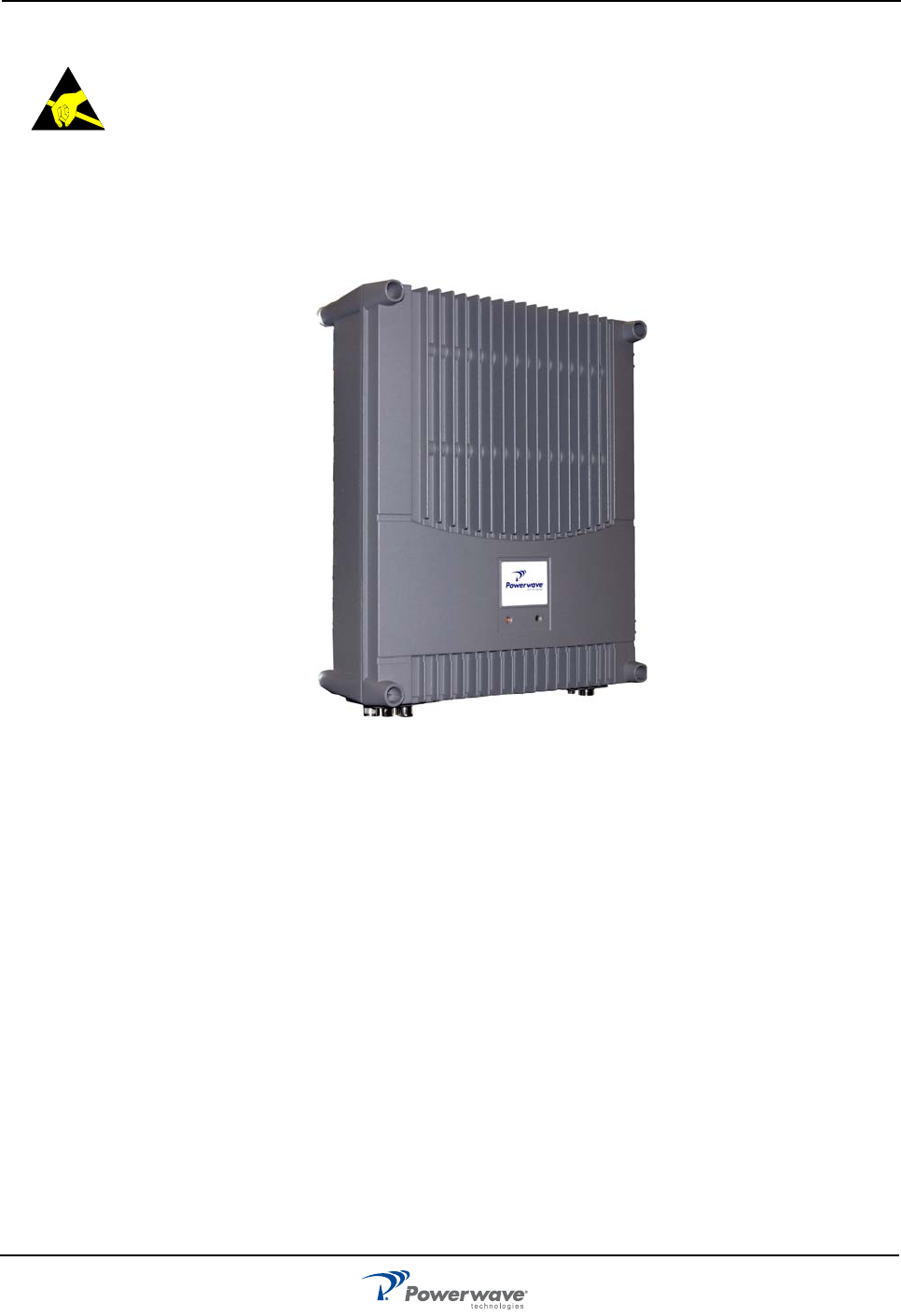
High Power Wideband Radio Head (WRH-V) Overview
044-05251 Rev B 1-3
Electrostatic Discharge (ESD)
ESD can severly damage essential parts of the equipment if not handled carefully. Parts on
printed circuit board assemblies (PCBA) as well as other parts in the equipment are sensitive
to ESD. Never touch the PCBA or uninsulated conductor surfaces unless absolutely
necessary.
If you must handle the PCBAs or uninsulated conductor surfaces, use ESD protective
equipment or first touch the chassis with your hand. Never let your clothes touch PCBAs or
uninsulated conductor surfaces and always store PCBAs in ESD-safe bags.
Overview
Figure 1-1 Powerwave Wideband Radio Head (WRH)
Powerwave WRH-Vs work as bi-directional on-frequency amplifiers used to extend coverage into uncovered
areas in wireless mobile systems such as base station fringe areas, tunnels, convention centers, airports and
buildings. It receives, amplifies, and transmits signals to/from a base transceiver station (BTS) to/from mobile
stations (MS) with both directions being served simultaneously. Connections to the WRH-V are made with N-
type or 7/16" male connectors.
WRH-Vs are microprocessor controlled with alarm and operational status LEDs visible on the front cover.
Cooling is provided through convection heat dissipation. Operational parameters, such as gain and power
levels are set using a PC running Powerwave OM-Online software which communicates with the WRH-Vs
either locally or remotely via modem. Remote operation can be performed via PSTN or a GSM net. The
Operation and Maintenance System (OMS) provides for Network Operations Center (NOC) configuration and
alarm monitoring.
WRH-Vs can be configured in many combinations depending on the wireless system, single or double system
operation, and output power. The following paragraphs provide a description of the different models of WRH-
Vs available.
The WRH-V is a fiber fed system designed to provide a high output power level and comes equipped with a
MCPA in the downlink path. The MCPA restricts the number of bands to one in the cabinet and one additional
band if a high cover is used. The MCPA is located in the cabinet and is supplied from the existing PSU.
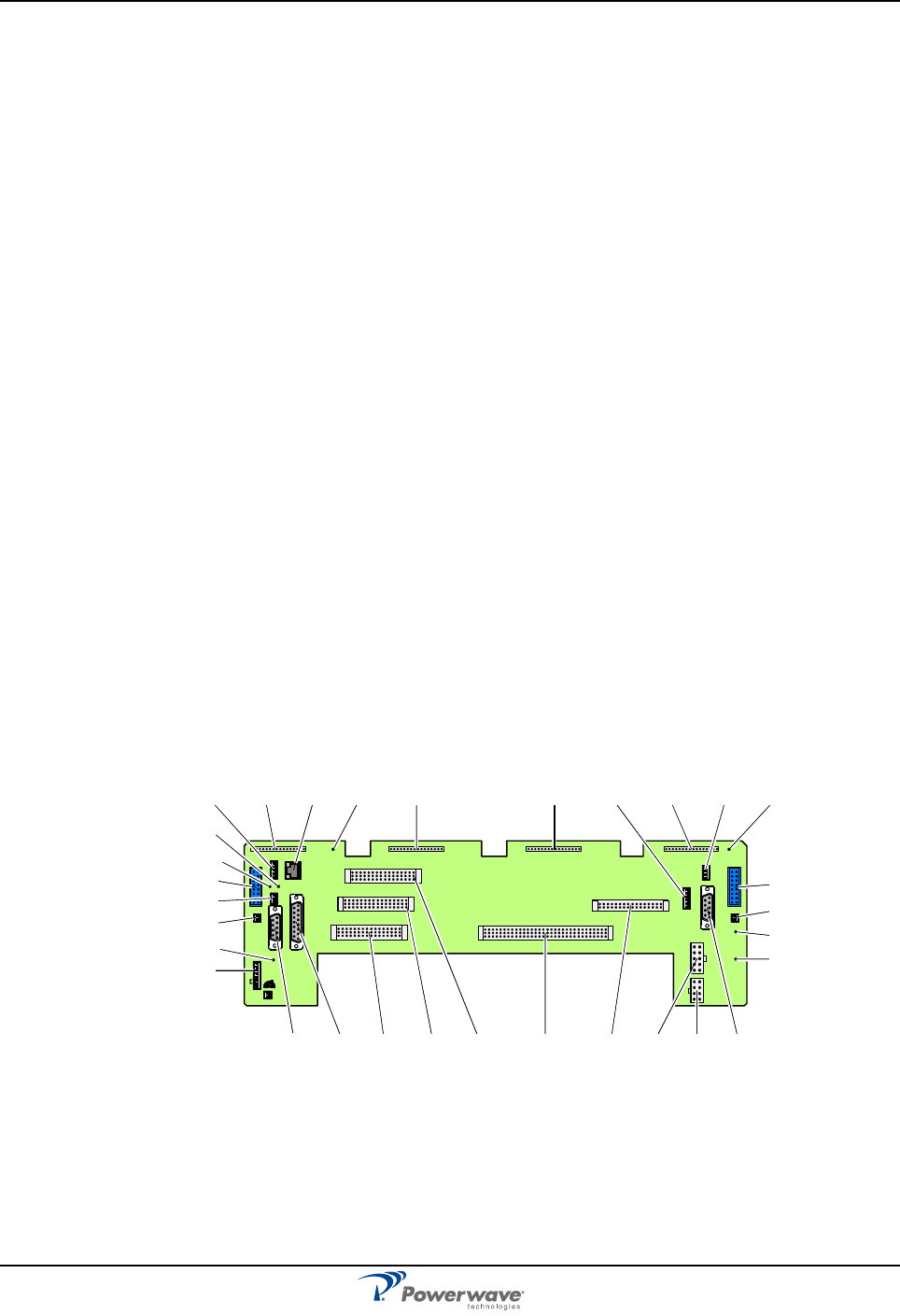
Overview High Power Wideband Radio Head (WRH-V)
1-4 044-05251 Rev B
Chassis Design
The WRH-V is housed in a cast aluminium waterproof chassis, class NEMA4 / IP65, approved for outdoor use
but is also suited for indoor installations. The chassis consists of a cabinet and a cover attached with hinges.
The cabinet contains the WRH-V circuitry. The cover comes as either a low or high version. The high cover can
be used as an empty cover or be equipped as a part of the WRH-V or an independent WRH-V unit. A WRH-V
with a high cover that is equipped as two independent units can, for example, be equipped for channel selective
operation in the cabinet and band selective operation in the cover.
Inside the WRH, a number of amplifier PCBAs are individually shielded and located under a metal cover that
can be opened outward. These PCBAs are of different types depending on the supported system.
Sub Unit Overview
A number of amplifier PCBAs are individually shielded and located under a metal cover inside the WRH-V. This
cover can be opened outward for access. These amplifier PCBAs are of different types depending on the
supported system. All of the WRH-Vs are built up with a number of sub units which are described in the
following sections.
Wideband Amplifier PCBA (WBA)
WRH-Vs can handle multiple carriers over a wide band. Each band requires one WBA for the uplink and
downlink, and one associated PA or MCPA for the downlink. The cabinet can be equipped with up to two WBAs
along with two PAs supporting two bands or one MCPA supporting one band. Positions 1 and 3, shown in
Figure 1-6, are assigned for a WBA.
Multi-Carrier Power Amplifier PCBA (MCPA)
The MCPA is used to amplify the output signal from the WBA. Each MCPA can handle one band in the downlink
direction. It requires an extra heat sink element on the outside of the cabinet or high cover to dissipate the heat
generated. The MCPA occupies positions 2 through 4 in the cabinet and 6 through 8 in a high cover, as shown
in Figure 1-6.
Distribution PCBA (DIA)
The DIA is the core distribution PCBA to which all other PCBAs and units connect in the cabinet with the
exception of the PA. Figure 1-2 shows a DIA PCBA. A shielded metal frame on the DIA provides the mounting
location for the CU, ALI and RCIs, if used.
Figure 1-2 DIA PCBA
ALLGON INNOVATION
SWEDEN M105 R6
1
PARKING
FOR W5
W5
8
P27 W6B 10
1
P33
ALARM
P23
LNA
UP-LINK
P32
MODEM
AUX1
P28
DOOR
5
9
61
116
1
1
M->S
P11
P34
8
9
15
P26
15 16
S->M
12
389
P36
5
X0A
X0B
2V2 116
P12 P13
1
1
1
16
16
16
P4
P5
P6
c
b
a
c
b
a
c
b
a
c
b
a
1P232
1
b
a
116P3
16 116
P14
1
V1
1
1
1
1
1
4
6
1
15
6
915
2
16
1
2
4
5
8
5
P35
P21
PSU
6
10
P31
PC
P29
P24
P25
GND
7
6V6
LNA
DOWN-LINK
LED
P22
1
2
V6B
P27
P26
P23
XOA
XOB
P28
P4 P5 P6 P2 P3 P31 P21 P35 P33
P32
P11 P12 P13 V1P14 P22P29P34 V2P36
V6
GND
P25
P24
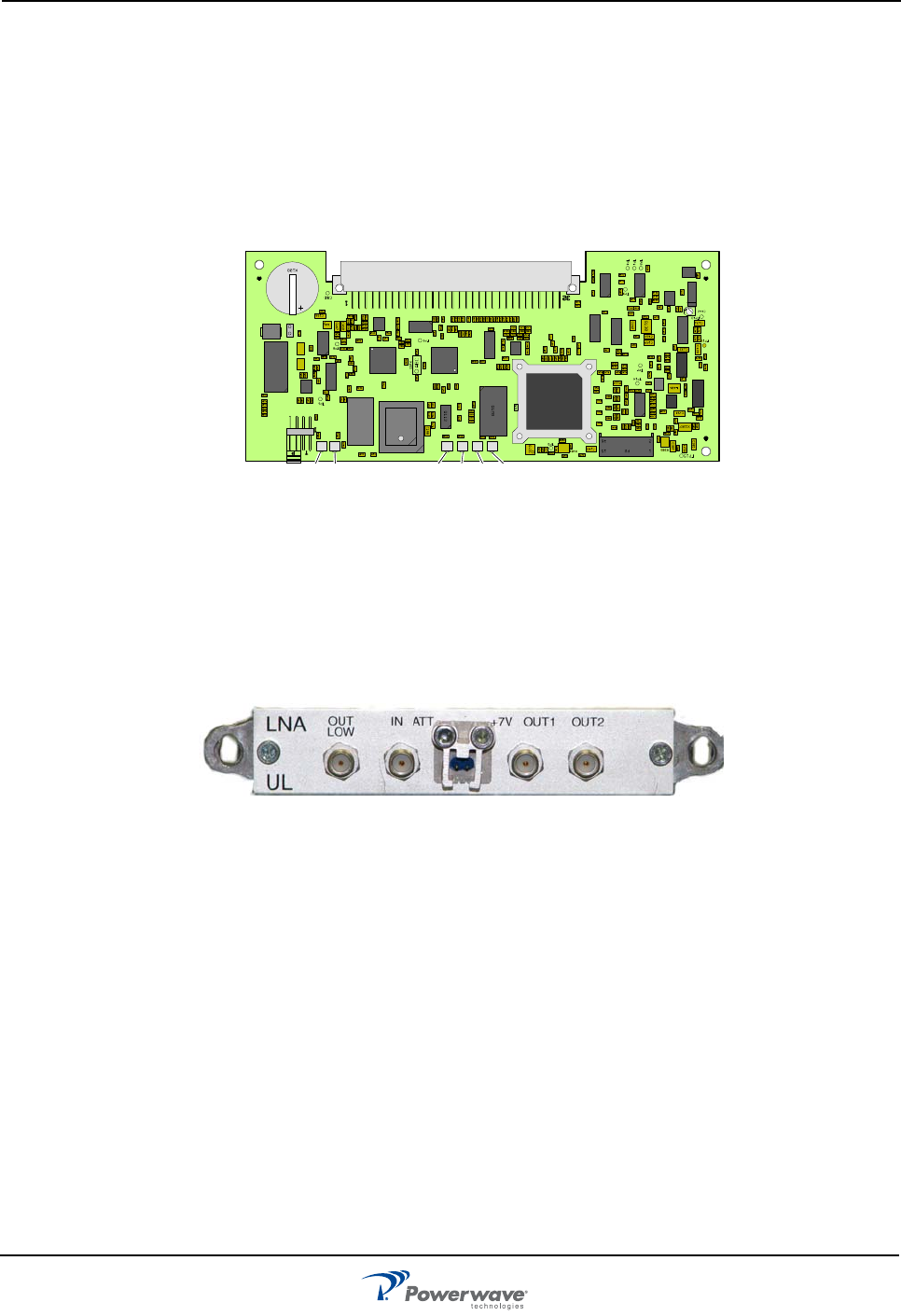
High Power Wideband Radio Head (WRH-V) Overview
044-05251 Rev B 1-5
Control Unit PCBA (CU)
Figure 1-3 shows the CU, which is the core microprocessor controller in the WRH-V and is connected to P2 on
the DIA. The CU contains a microprocessor, main memory, flash memory for the CU software, EEPROM
memory for parameters, memory for the event log and statistics, a REFO reference oscillator, ports for local
and remote communication, a battery powered real-time clock, and a MAC identity circuit. It supervises and
controls operational parameters such as gain control and channel handling, alarms, the event log, the
password and the logon. The CU is also a control interface for OM-Online and OMS. Software for the CU can
be downloaded from OM-Online, either locally or remotely. It is located in the lower right part of the shielded DIA
frame.
Figure 1-3 CU PCBA
Low Noise Amplifier (LNA)
LNAs are used on the uplink and are located at the top of the cabinet and the high cover, if equipped. An
example of an LNA is illustrated in Figure 1-4. All of the coaxial connectors are SMA-type. Signals from the DPX
output are fed to the LNA input connector (IN). The OUT1 and OUT2 outputs feed the WBAs in the UL direction.
The signal level at these connectors is +20dB referenced to the antenna input. The other output, OUT LOW, is
an expansion output for an additional LNA if the WRH-V is equipped with a unit in the cover part of the chassis.
The gain to this connector is +2dB. The +7V input is used for +7V supply from the DIA PCBA and the ATT
connection is for the control signal for a controllable attenuator in the LNA.
Figure 1-4 LNA
Duplex Filter (DPX)
DPXs are located on the metal cover sheet in the upper part of the cabinet.
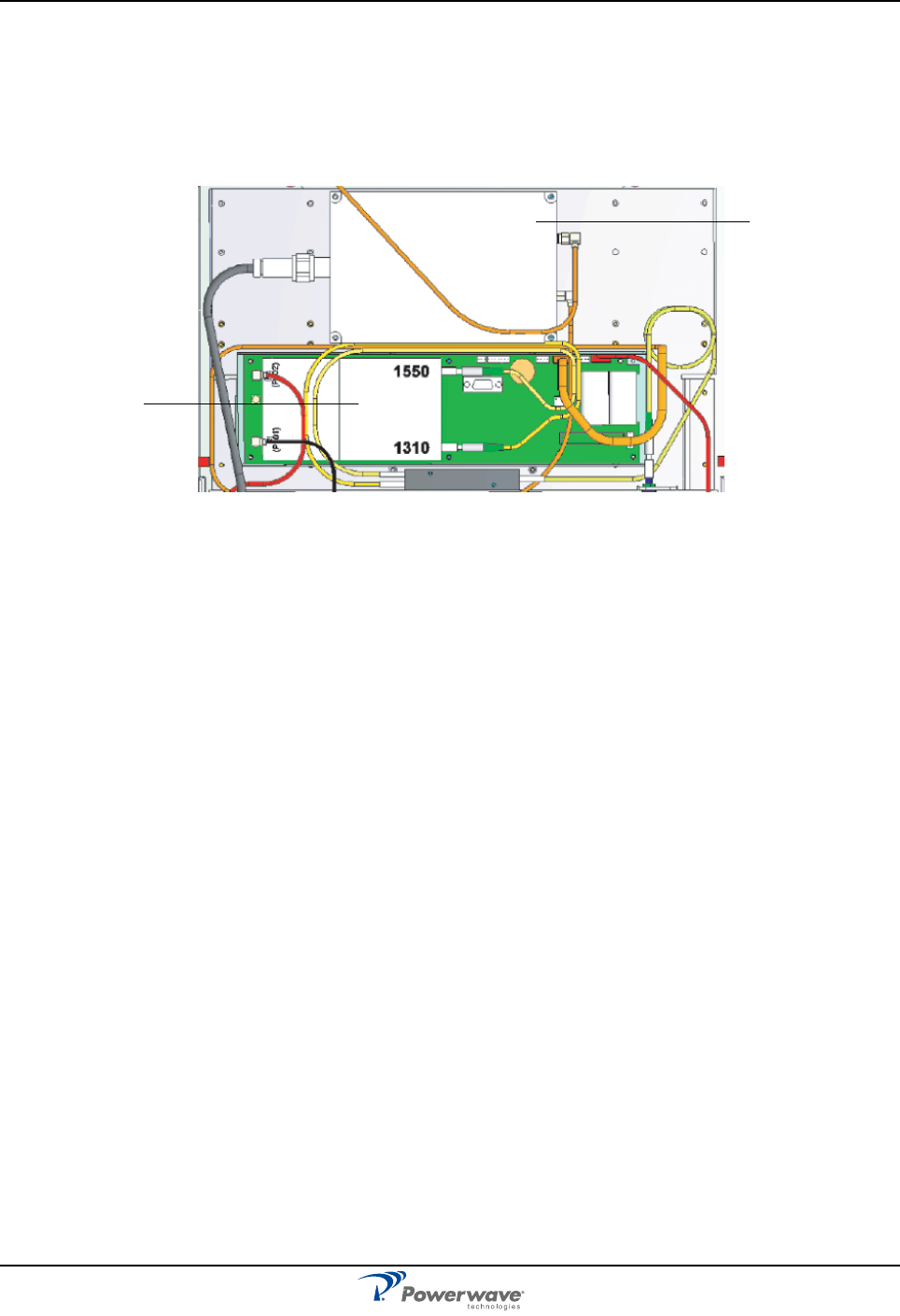
Overview High Power Wideband Radio Head (WRH-V)
1-6 044-05251 Rev B
Fiber Optic Unit (FOU)
The FOU is a metal plate mounted on top of the cover plate in the upper part of the WRH. The FON and fiber
optic connectors are mounted on the FOU. Figure 1-5 illustrates an FOU with the FON and fiber optic
connectors mounted on the plate. It can also be configured with combiners, splitters, and Wave Division
Multiplexers (WDMs) to obtain a desired combination of several branches with double or single fiber.
Figure 1-5 FOU in WRH-V
Fiber Optic Node (FON)
The FON is the main part of the FOU. It is a bi-directional electrical/optical signal converter and a node in a fiber
network. In addition, the FON has all the functionality included in the CU PCBA and contains battery backup.
It has also functionality for:
• Electrical and optical signal supervision
• Internal and external alarm handling
• RS232 interface for local PC control via an O&M software (OM-Online)
• Remote control via an O&M software (OM-Online or OMS)
• Interfaces for RCU and FLI
• Battery backup with charger
There are two versions of the FON; one with three SMA ports (UL, DL and RX Mon) and the other with four SMA
ports (UL, DL, RX Mon and TX Mon). The FON also has two optical ports for DL and UL fiber connections.
Power Supply Unit (PSU)
The PSU supplies DC power to all of the components in the WRH-V.
Remote Control Unit (RCU)
The RCU is an optional communication unit for remote control of WRH-Vs via PSTN or RF modems. RCU types
and details are described in Chapter 4.
Alarm Interface PCBA (ALI) and Remote Control Interface PCBA (RCI)
The ALI handles alarms and alarm communication. It is replace with an RCI if an RCU is used and provides an
interface between the CU and an RCU for remote communication via modem. The RCI also handles alarms
and alarm communication. Either unit is located in the lower left part of the shielded DIA frame.
FON
DPX
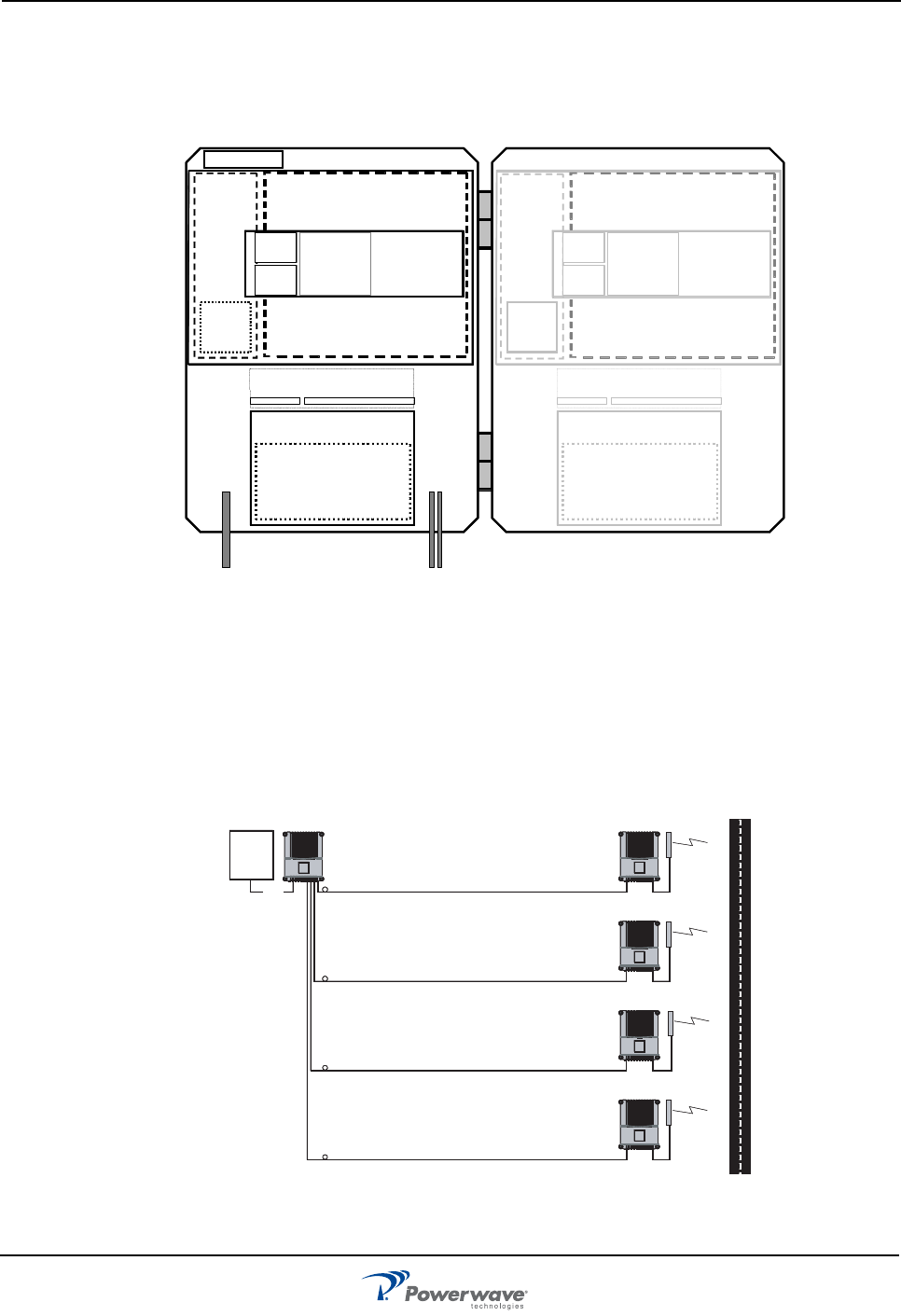
High Power Wideband Radio Head (WRH-V) Overview
044-05251 Rev B 1-7
Sub Unit Locations
The MCPA is located at positions 3 and 4 in the cabinet. A WRH-V is equipped for one band in the cabinet and,
if required, an additional band in a high cover. PCBA positions are illustrated in Figure 1-6 and a block diagram
is located in Appendix A.
Figure 1-6 WRH-V Sub Unit Locations
Fiber Optic Distribution Networks
Fiber optic networks are setup identically to data networks. WRH-Vs are connected in a star configuration as
illustrated in Figure 1-7. In this example, a Base Station Master Unit (BMU) is fed by a BTS via an RF cable. An
Optical Converter Module (OCM) could also be used depending on the system configuration. The BMU or OCM
contain three FONs and provide continuity to the FONs in the four WRHs. By using WDMs and Optical Splitters
(OSPs) in the WRHs, the distribution net can be built up with a combination of star and daisy-chain connections
using double or single fiber.
Figure 1-7 Fiber Optic Star Configuration
1234
LNA - UL
PSU
(RCU)
DPX
CUALI/RCI
WBA
DL/UL
FOU
MCPA DL 5678
PSU
(RCU)
DPX
CUALI/RCI
WBA
DL/UL
FOU
MCPA DL
FON FON
BMU WRH
WRH
WRH
WRH
BTS
RF
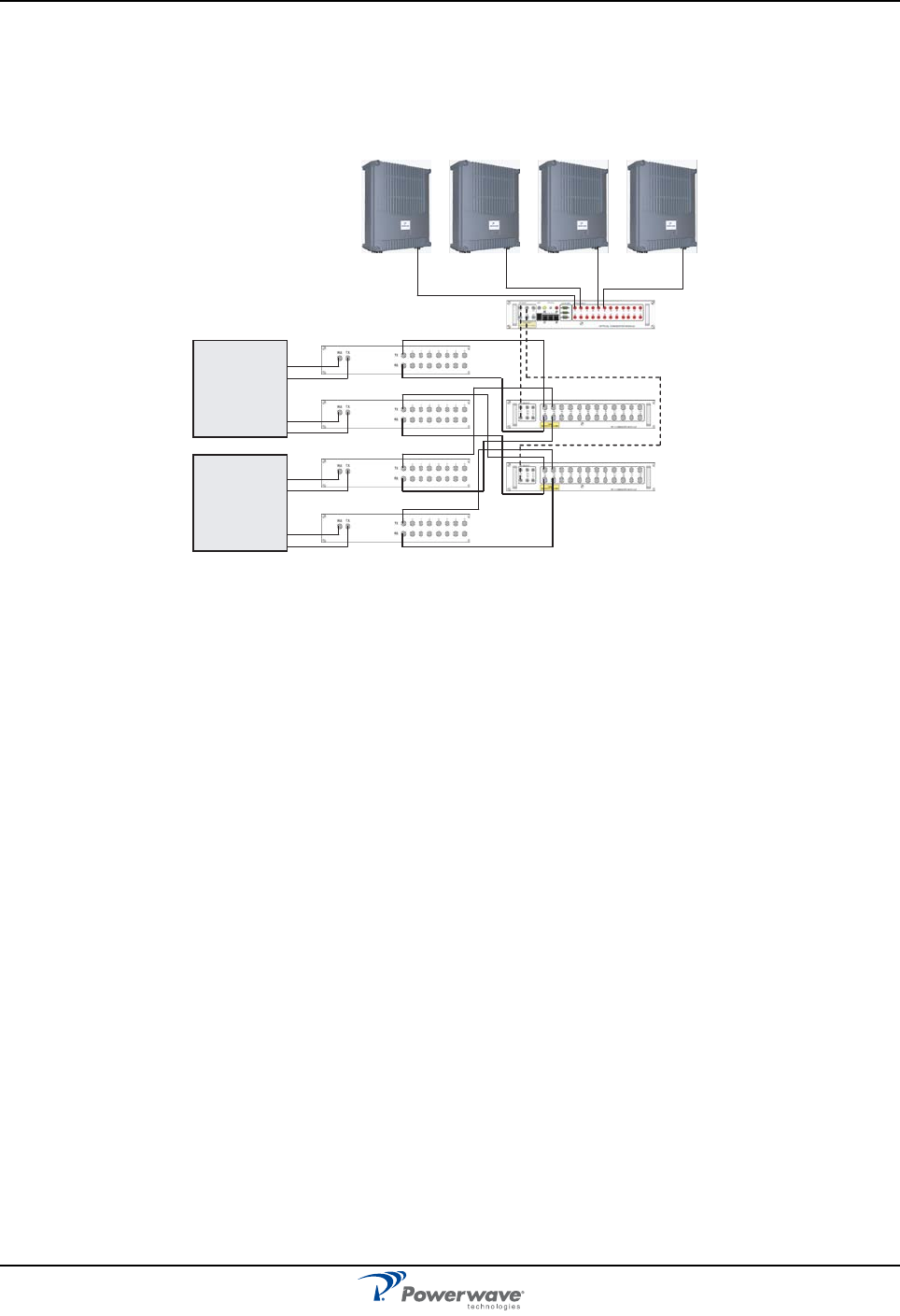
Overview High Power Wideband Radio Head (WRH-V)
1-8 044-05251 Rev B
This page intentionally left blank
Multi-Operator Configurations
Multi-operator systems require the use of Point of Interconnect (POI) units and OCMs as illustrated in Figure
1-8. In this simple example, two operators have two sectors each. Each sector is connected to a POI and then
to a RCM. The RCM is interconnected with an OCM via coaxial cables. The combined DL and UL signals are
converted to optical signals in the OCM and then distributed to the WRHs-V.
Figure 1-8 Multi-operator System
Operator 1
Operator 2
Sector 1
Sector 1
Sector 2
Sector 2
OCM
OCM-POI
BTS-POI
BTS-POI
BTS-POI
BTS-POI
OCM-POI
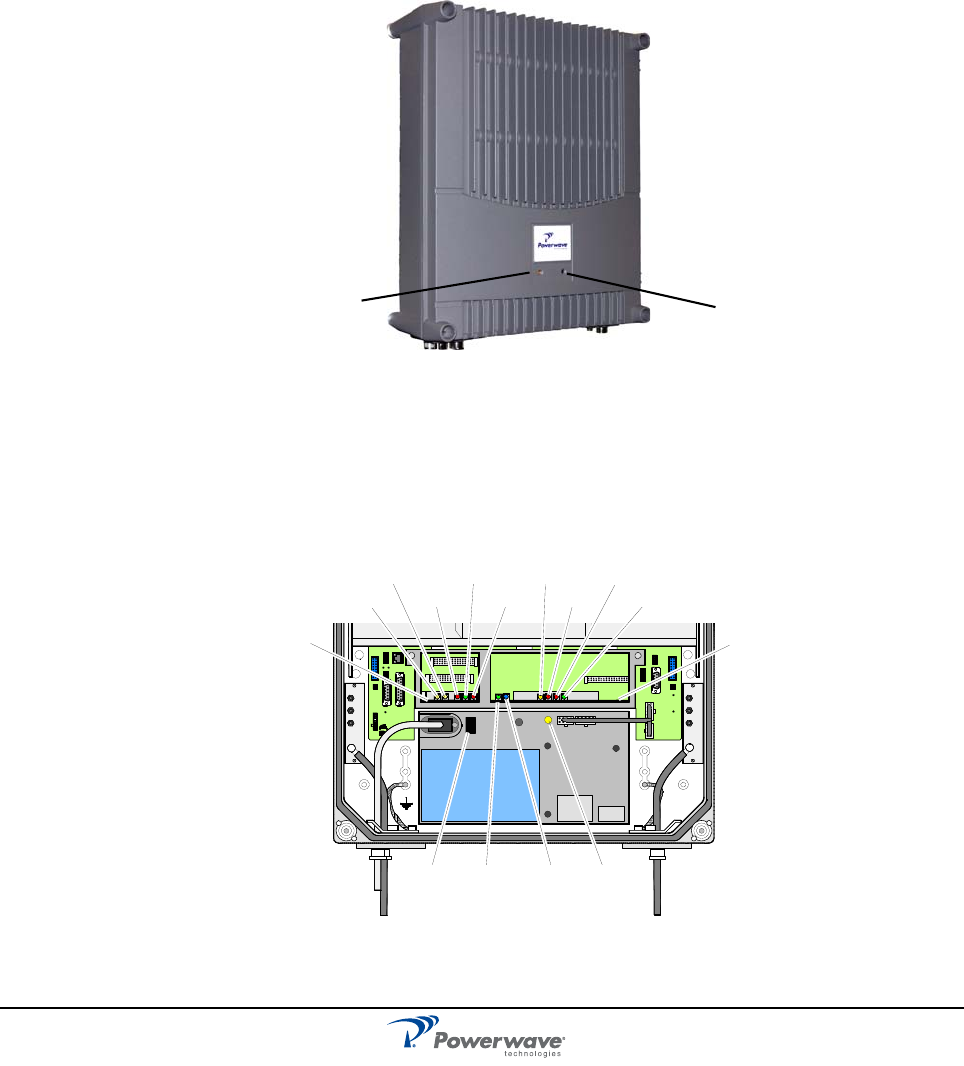
044-05251 Rev B 2-1
Chapter 2
Controls, Indicators and Connectors
Introduction
This chapter contains descriptions of the controls, indicators and connectors for the WRH.
Front Cover Indicators
Figure 2-1 External Indicators
Two LEDs, shown in Figure 2-1, are located on the front cover to provide easy identification of a fault in the
system. The amber operation LED lights up approximately 15 seconds after the main power is switched on.
When the LED is steady, the WRH-V is ready for operation. The red alarm LED indicates a system error alarm
when flashing and a critical alarm when steady.
Cabinet Indicators
Figure 2-2 Cabinet Internal Indicators
Red
Amber
MS
DPX
ANT
TEST
DC
-30 dB
-20 dB MS
DPX
ANT
TEST
DC
-30 dB
-20 dB
ALLGON IN NOVAT ION
SWEDEN M105 R6
1
PARKING
FOR W5
W5
8
P27 W6B 10
1
P33
ALARM
P23
LNA
UP-LINK
P32
MODE M
AUX1
P28
DOOR
5
9
61
116
1
1
M->S
P11
P34
8
9
15
P26
15 16
S->M
12
389
P36
5
X0A
X0B
2V2 116
P12 P13
1
1
1
16
16
16
P4
P5
P6
c
b
a
c
b
a
c
b
a
c
b
a
1P232
1
b
a
116P3
16 116
P14
1
V1
1
1
1
1
1
4
6
1
15
6
915
2
16
1
2
4
5
8
5
P35
P21
PSU
6
10
P31
PC
P29
P24
P25
GND
7
6V6
LNA
DOWN-LINK
LED
P22
1
2
POWER SUPPLY UNIT
CU
ALI
or
RCI
SV
OPER
FAULT
POWER
10V ALARM
POWER
BOOT
FAULT
OPER
WLI / R2R DATA
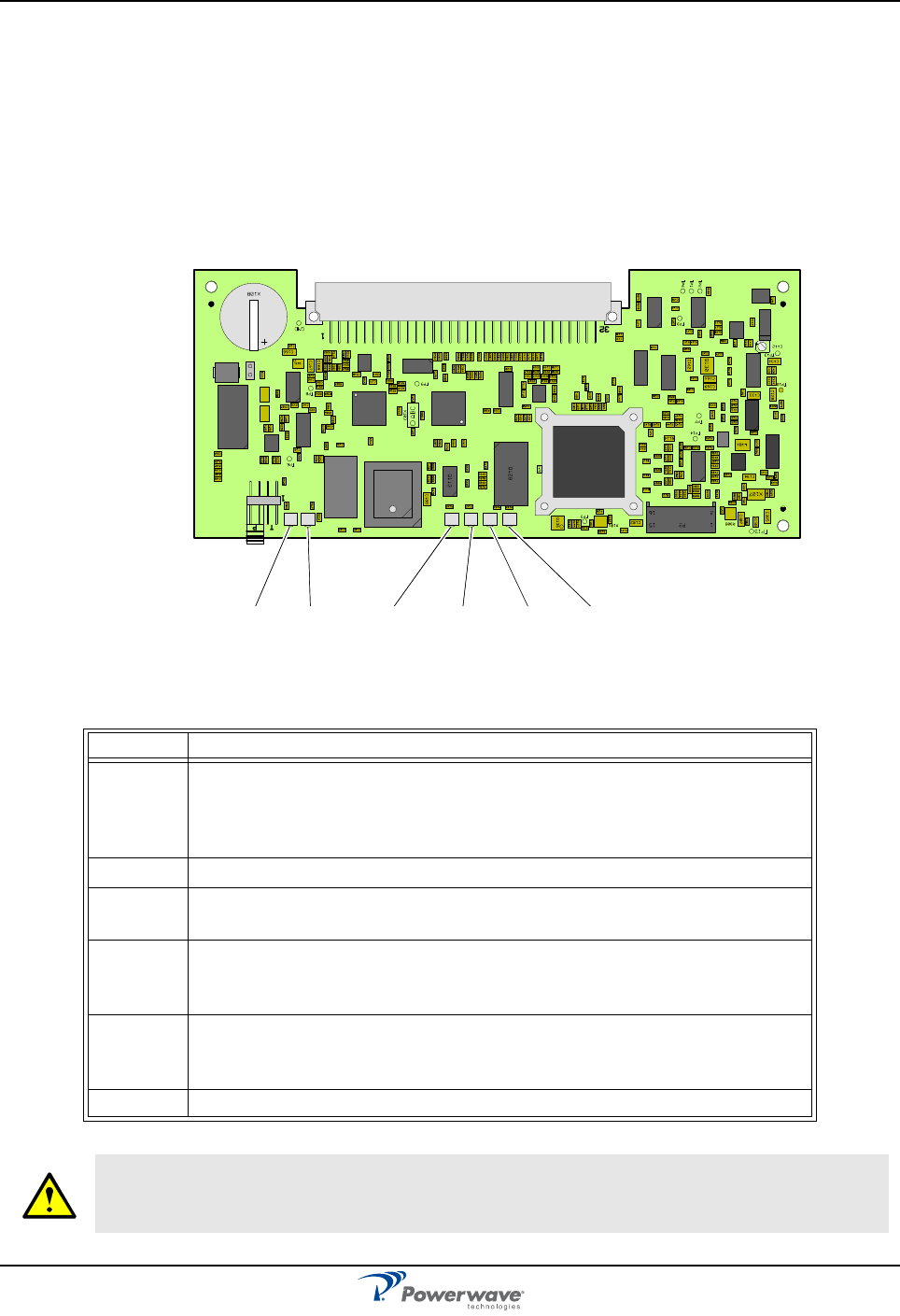
PCBA Indicators High Power Wideband Radio Head (WRH-V)
2-2 044-05251 Rev B
Figure 2-2 shows the LED indicators located on the ALI or RCI, the CU PCBAs, the 115/220V main power
switch (S) in the cabinet, and the voltage indicator (V). These indicators are described in further detail in the
following sections.
PCBA Indicators
This following paragraphs describe the LED indicators on the main PCBAs inside the WRH.
CU PCBA
Figure 2-3 shows the location of the LEDs on the CU and Table 2-1 lists their indications.
Figure 2-3 CU PCBA Indicators
Table 2-1 CU PCBA LED Indicators
LED Description
WLI Wire Link Interface. A flashing green LED indicates the unit is receiving
data over the subcarrier. A steady green LED indicates: the unit is
currently not receiving any data, is currently not a control station or there
is no other node in the network
DATA Blue LED indicating data transmission in the W-net
POWER Yellow LED indicating present power and remains steady after power is
switched on
BOOT Steady red LED when the CU boots (10 – 15 seconds after main power is
switched on), then flashing red (5 – 10 seconds), then off if no error is
detected. If an error is detected LED will stay on
FAULT Flashing red LED for 15 – 20 seconds after main power is switched on.
Flashes for less serious alarms (Error) and is on solid for fatal alarms
(Critical)
OPER Steady green LED indicates WRH-V is ready for operation
WARNING: A lithium battery is permanently mounted on the CU PCBA. Due to risk of
explosion, this battery must not be removed. In case of battery malfunction, replace the
CU PCB.
WLI DATA POWER BOOT FAULT OPER
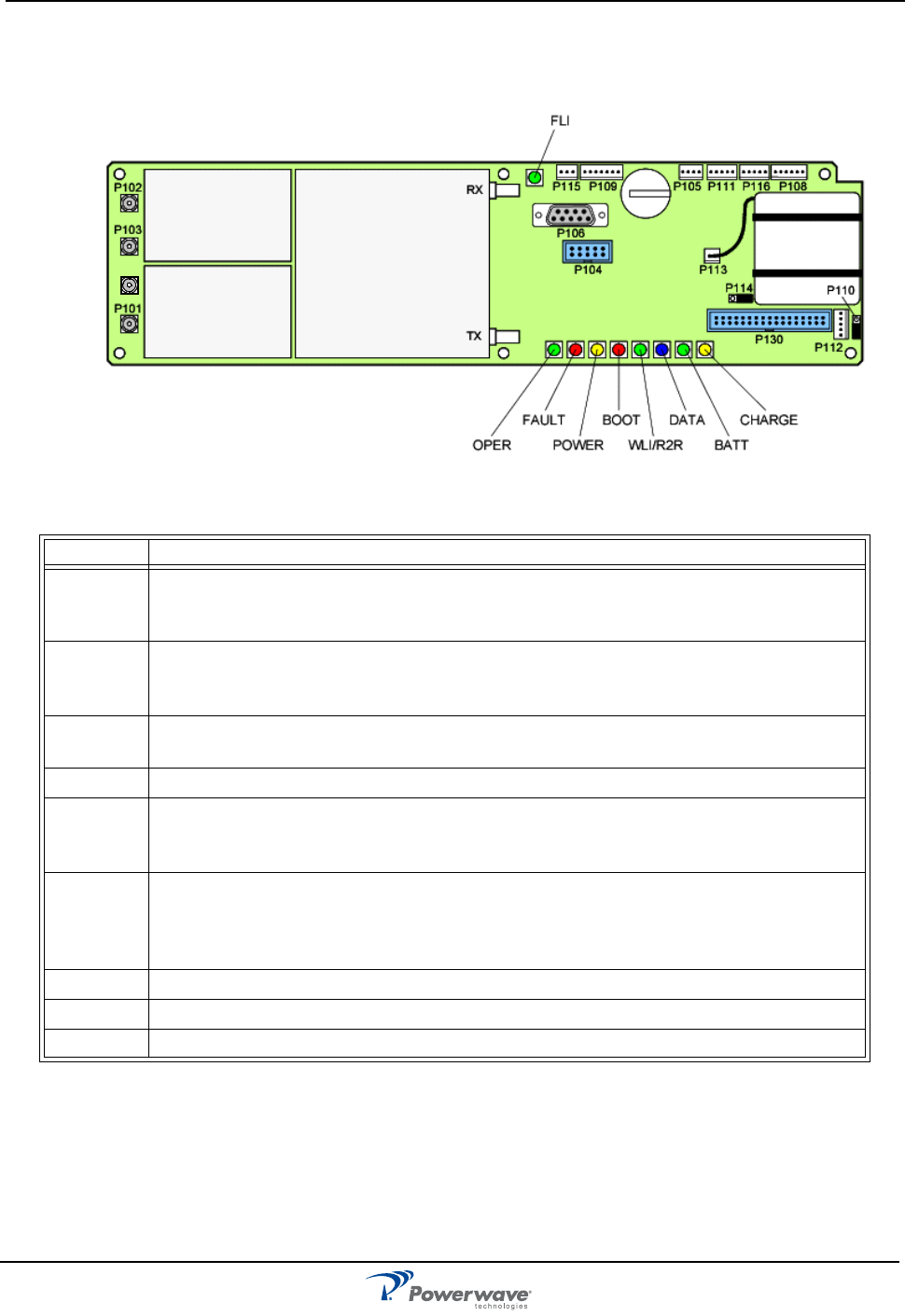
High Power Wideband Radio Head (WRH-V) PCBA Connections
044-05251 Rev B 2-3
FON PCBA
The FON is shown in Figure 2-4 and the LED indicators are listed in Table 2-2.
Figure 2-4 FON LED Indicators
Table 2-2 FON LED Indications
PCBA Connections
The following tables list the connections from the main PCBAs to replaceable units inside the WRH-V. Table
2-3 lists the connections for a WRH-V configured for PCS both with and without diversity and Table 2-4 lists
the connections for Cellular with and without diversity.
LED Description
FLI or
F2F
Green LED. Fiber Line Interface (FLI). Flashing LED indicates the unit is receiving
data over the sub carrier. A steady LED indicates the unit has detected an FLI sub-
carrier, but is not carrying any data
OPER Green LED. Lights up for approximately 5 seconds after the power is switched on.
The LED is dark during the boot process and when it is steadily lit again, it indicates
the unit is ready for operation
FAULT Red LED. Flashes for 15 – 20 seconds after the mains is switched on. Will flash for
less serious alarms and be steady for fatal alarms
POWER Yellow LED. Indicates power is present
BOOT Red LED. Steady LED when the control unit boots up (10 – 15 seconds after the
mains is switched on). Next enters a flashing state for 5 – 10 seconds. If no error is
detected, the LED turns off. If an error occurs, the LED remains on
WLI Green LED. Wire Link Interface. Flashing LED indicates unit is receiving data over
the subcarrier. A steady LED indicates one of the following: The unit is not currently
receiving any data, the unit is not currently a control station or there is no other node
in the network
DATA Blue LED. Indicates data transmission in the W-net
BATT Green LED. Steady LED indicates battery pack is currently used as power source
CHARGE Yellow LED. Steady LED indicates battery charging
P117
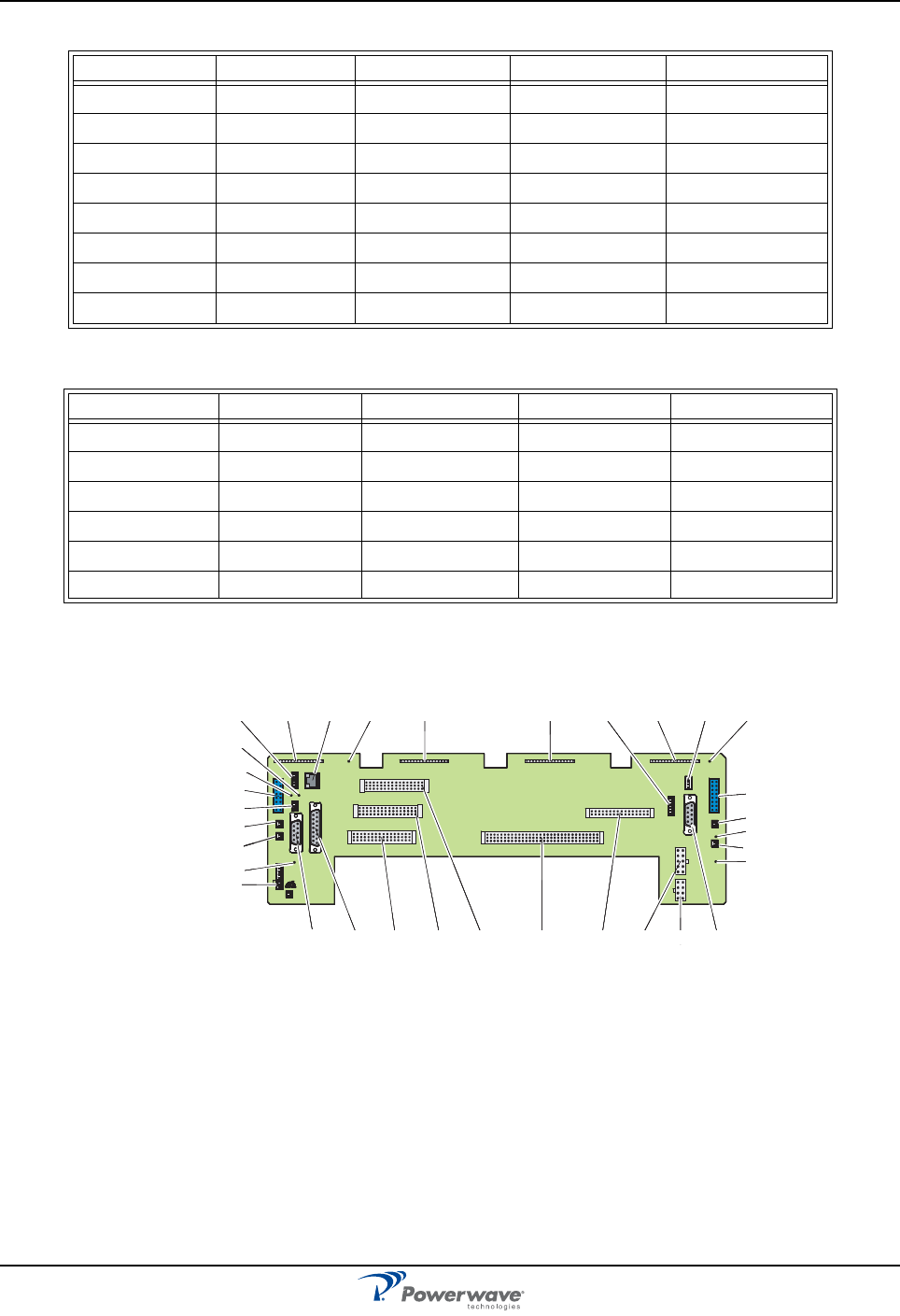
PCBA Connections High Power Wideband Radio Head (WRH-V)
2-4 044-05251 Rev B
Table 2-3 WRH-V Base Unit Connections
Table 2-4 WRH-V Cover Unit Connections
DIA PCBA
Figure 2-5 shows and Table 2-5 lists the connections on the DIA PCBA. The DIA provides most of the internal
connection between the sub units and external ports. Connectors involved are also located on the DIA.
Figure 2-5 DIA PCBA Connectors and Testpoints
The External Alarm Port P33 is used for external alarm sensors and alarm equipment. The four alarm inputs
are low-level inputs with common ground (AIC). Use an insulated switch or relay to initiate alarms (open
switches in normal operating mode, closed switches cause alarm). The alarm switch connection can be
toggled between active open and active closed. The alarm input voltage ratings, related to ground (AIC), are:
Vinmax= 5.5V, Vinmin= –0.5V.
The four alarm inputs are connected to the following pins:
Pin 14 AI1 External alarm input 1 - EAL1
Pin 15 AI2 External alarm input 2 - EAL2
Pin 7 AI3 External alarm input 3 - EAL3
Pin 8 AI4 External alarm input 4 - EAL4
From To Cable Number Non-Diversity Diversity
WBA P2401 M FON P101 VE007 06/3 Used Used
WBA P3401 D FON P101 700-16639-001 Not Used Used
WBA P1101 M FON P102 VE007 20/2 Used Used
PSU DIA P21, P35 VE007 98/1 Used Used
M FON P108 DIA P29 VE007 66/1 Used Used
D FON P108 M FON P116 VE007 66/1 Not Used Used
M FON P111 DIA P36 VE008 05/1 Used Used
D FON P111 DIA P112 VE008 05/1 Not Used Used
From To Cable Number Non-Diversity Diversity
Cover DIA P36 M FON P112 VE008 05/1 Used Not Used
Cover DIA P36 D FON P112 VE008 05/1 Not Used Used
PSU DIA P21, P35 VE007 98/1 Used Used
DX DL C M FON P102 700-14508-401 Used Used
DX UL1 C (M) M FON P101 700-14508-401 Used Used
DX UL2 C (D) M FON P101 VE007 52/2 Not Used Used
ALLGON INNO VATION
SWEDEN M105 R6
1
PARKING
FOR W5
W5
8
P27 W6B 10
1
P33
ALARM
P23
UL LNA ATT N
P32
MODEM
AUX1
P28
DOOR
5
9
61
116
1
1
M->S
P11
P34
8
9
15
P26
15 16
S->M
12
3
89
P36
5
X0A
X0B
2
V2 116
P12 P13
1
1
1
16
16
16
P4
P5
P6
c
b
a
c
b
a
c
b
a
c
b
a
1P232
1
b
a
116P3
16 116
P14
1
V1
1
1
1
1
1
4
6
1
15
6
915
2
16
1
2
4
5
8
5
P35
P21
PSU
6
10
P31
PC
P29
P24
P25
GND
7
6V6
UL LNA ATTN
LED
P22
1
2
V
6B
P26
XOA
XOB
P28
P4 P5 P6 P2 P3 P31 P21 P35 P33
P32
P11 P12 P13 V1P14 P22P29P34 V2P36
V6
GND
P25
P24
P27
P23
1
2
P37
DIV 1
2
P38
DIV
P38
ALLGON INNO VATION
SWEDEN M105 R6
1
PARKING
FOR W5
W5
8
P27 W6B 10
1
P33
ALARM
P23
UL LNA ATT N
P32
MODEM
AUX1
P28
DOOR
5
9
61
116
1
1
M->S
P11
P34
8
9
15
P26
15 16
S->M
12
3
89
P36
5
X0A
X0B
2
V2 116
P12 P13
1
1
1
16
16
16
P4
P5
P6
c
b
a
c
b
a
c
b
a
c
b
a
1P232
1
b
a
116P3
16 116
P14
1
V1
1
1
1
1
1
4
6
1
15
6
915
2
16
1
2
4
5
8
5
P35
P21
PSU
6
10
P31
PC
P29
P24
P25
GND
7
6V6
UL LNA ATTN
LED
P22
1
2
V
6B
P26
XOA
XOB
P28
P4 P5 P6 P2 P3 P31 P21 P35 P33
P32
P11 P12 P13 V1P14 P22P29P34 V2P36
V6
GND
P25
P24
P27
P23
1
2
P37
DIV 1
2
P38
DIV
P38

High Power Wideband Radio Head (WRH-V) PCBA Connections
044-05251 Rev B 2-5
Pin 6 AIC Ground.
Two alarm outputs are 1 pole closing and 1 pole opening relay outputs insolated from each other. Maximum
ratings, related to ground or any other alarm terminal, are 50 VAC / 60 VDC. The alarm outputs are defined as
follows:
Pin 9 and 1 AO1 and AO8 Closed when operating, otherwise open.
Pin 10 and 2 AO6 and AO7 Open when operating, otherwise closed.
Pin 11 and 3 AO2 and AO5 Closed at alarm state, otherwise open.
Pin 12 and 4 AO3 and AO4 Open at alarm state, otherwise closed.
LNA
Figure 2-6 shows the front of the LNA and Table 2-6 lists the connections.
Table 2-5 DIA PCBA Connections
Port Connected to
P2 CU PCBA
P3, 5, 6 Not Used
P4 ALI or RCI PCBA
P11 - 14 Channel PCBA positions 1 through 4
P21 PSU, connector 1
P22 LED PCBA in cover
P23 LNA/UL
P24 LNA/DL
P25 Expansion output port to cover circuitry. Only in cabinets
P26 Expansion input port to cover circuitry. Used in equipped high covers
P27 Auxiliary Port (8-pin male) - Pins 2 and 3 must always be interconnected to
provide the CU and ALI/RCI PCBAs with voltage. If there is no cable
connected, pins 2 and 3 must be interconnected with a jumper
P28 Door switch port - Normally, alarm input AI4 is used for door opening alarm
EAL4 which is arranged using an optional door switch. Signal AI4 and AIC
are thus available also in the P28 connector, to which the door switch is
connected. The EAL4 door switch alarm is activated 10 – 30 seconds after
the cover has been opened
P29 Power to FON
P31 RS-232 PC Port (9-pin D-sub female) - Used for local PC communication
P32 RS-232 Modem port (9-pin D-sub male)
P33 External Alarm Port (15-pin D-sub female) - Used for external alarm sensors
and alarm equipment. Four alarm inputs, EAL1 – EAL4, and two alarm
outputs
P34 Not used
P35 PSU, connector 2
P36 IP or R2R connection between CU and FON
P37 LNA Diversity DL
P38 LNA Diversity UL
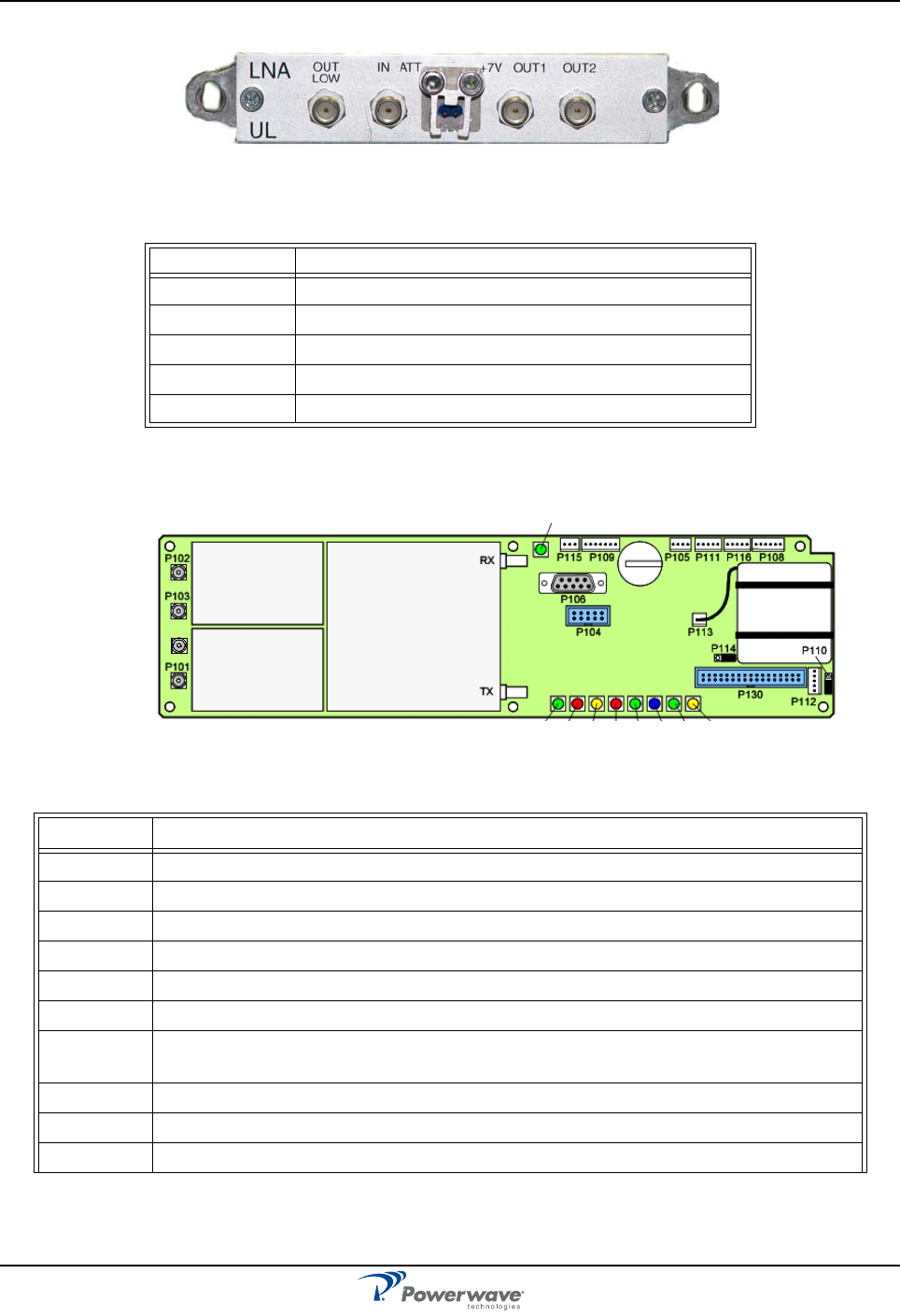
PCBA Connections High Power Wideband Radio Head (WRH-V)
2-6 044-05251 Rev B
Figure 2-6 LNA
Table 2-6 LNA Connections
FON
Figure 2-7 shows the locations of the connectors on the FON and Table 2-7 lists the port numbers, connector
types, and port usage.
Figure 2-7 FON Connector Locations
LNA Port Connected to
OUT LOW IN on the LNA/UL in the cover, if equipped
IN LO on the service DPX duplex filter
ATT +7V P23 on the DIA PCBA
OUT1 P2101 on the WBA PCBA
OUT2 Diversity LNA connected to P3101 on WBA PCBA
Table 2-7 FON Connectors
Port Description
P101 SMA, electrical RF input port (to the optical TX port)
P102 SMA, electrical RF output port (from the optical RX port)
P103 SMA, electrical RF output port (15dB below the P102 port)
RX DIN/APC, optical input port (to the P102 and P103 RF ports)
TX DIN/APC, optical output port (from the P101 RF port)
P104 Used only for development and debugging
P105 4-pin male, door LED indicators. Used for the yellow and red LED indicators located
on the front cabinet door
P106 9-pin D-sub female, RS-232 used for local PC communication
P108/116 6-pin male, parallel connected power ports for the FON
P109 7-pin male, used for external alarm sensors
P117
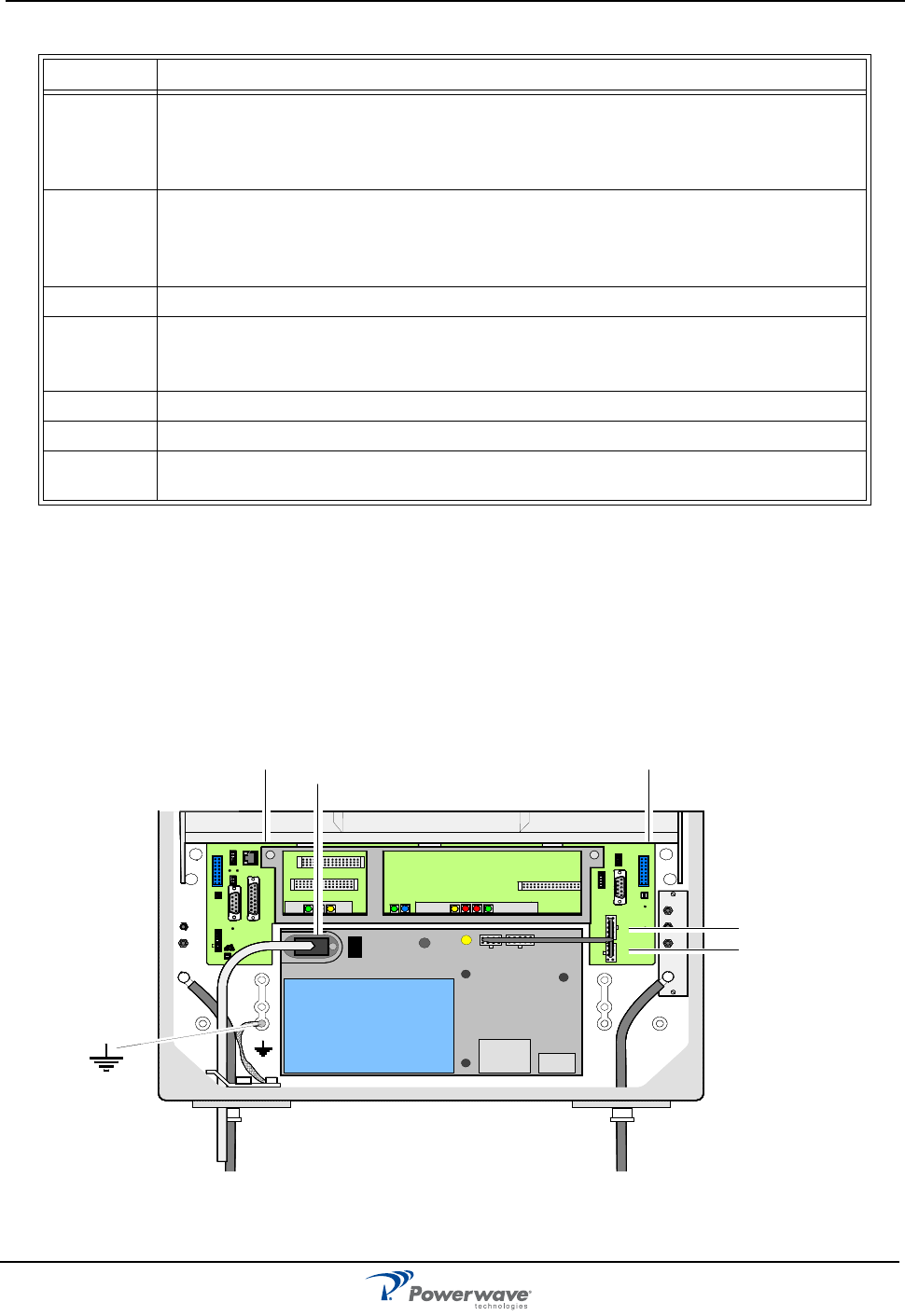
High Power Wideband Radio Head (WRH-V) PCBA Connections
044-05251 Rev B 2-7
PSU
The PSU is located in the bottom middle of the cabinet or in an equipped high cover. The PSU has all the
voltages required for the WRH. It has capacity for the radio circuitry, fiber optics, and modem. Multi-band
WRH-Vs always require a second PSU. There are two PSU types with different input voltages:
1. 115/230V 50/60Hz, 300W input max.
2. 21- 60V DC, 300W input max.
The PSU is connected to the DIA at P21 and P35, and voltage is tested at V1 (test point for P35) and V2 (test
point for P21).
Figure 2-8 PSU Location
P110 W-link jumper, used to terminate units in a W-link. It has to be set in the parking
state for all units except for the first and last units in a W-link. The Parking state (P)
has the jumper between the center and bottom pins. The opposite state, with the
jumper between the tip and center pins, terminates(T) the W-link
P111/112 5-pin male, WLI ports used for interconnecting nodes in WLI-nets (IP or R2R
networks). They are identical and connected in parallel. One of the connectors is
intended to be used from the previous node and the other connector to the next
node in the network. Either can be used for the first and the last unit in the net chain
P113 2-pin male, used for the on-PCBA backup batteries
P114 Backup power output jumper, sets the backup power output state. The OFF state
has jumper between the center and left pins. This jumper has to be in the OFF state
when used in an OCM. Otherwise, it shall be in the ON state
P115 3-pin male, intended for future use
P117 SMA, electrical RF output port (15dB below the P101 port)
P130 34-pin, 2-line male, RCU port used for connecting an RCU. The connector contains
both the modem connection and RCU power supply
Table 2-7 FON Connectors (Continued)
Port Description
MS
DPX
ANT
TEST
DC
-30 dB
-20 dB
POWER SUPPLY UNIT
ALLGON INNOVATION
SWE DEN M105 R6
1
PARKING
FOR W5
W5
8
P27 W6B 10
1
P33
ALARM
P23
LNA
UP-LINK
P32
MODEM
AUX1
P28
DOOR
5
9
61
116
1
1
M->S
P11
P34
8
9
15
P26
15 16
S->M
12
389
P36
5
X0A
X0B
2V2 116
P12 P13
1
1
1
16
16
16
P4
P5
P6
c
b
a
c
b
a
c
b
a
c
b
a
1P232
1
b
a
116P3
16 116
P14
1
V1
1
1
1
1
1
4
6
1
15
6
915
2
16
1
2
4
5
8
5
P35
P21
PSU
6
10
P31
PC
P29
P24
P25
GND
7
6V6
LNA
DOWN-LINK
LED
P22
1
2
P21
P35
V1V2 AC
Power
MS
DPX
ANT
TEST
DC
-30 dB
-20 dB
MS
DPX
ANT
TEST
DC
-30 dB
-20 dB
POWER SUPPLY UNITPOWER SUPPLY UNIT
ALLGON INNOVATION
SWE DEN M105 R6
1
PARKING
FOR W5
W5
8
P27 W6B 10
1
P33
ALARM
P23
LNA
UP-LINK
P32
MODEM
AUX1
P28
DOOR
5
9
61
116
1
1
M->S
P11
P34
8
9
15
P26
15 16
S->M
12
389
P36
5
X0A
X0B
2V2 116
P12 P13
1
1
1
16
16
16
P4
P5
P6
c
b
a
c
b
a
c
b
a
c
b
a
1P232
1
b
a
116P3
16 116
P14
1
V1
1
1
1
1
1
4
6
1
15
6
915
2
16
1
2
4
5
8
5
P35
P21
PSU
6
10
P31
PC
P29
P24
P25
GND
7
6V6
LNA
DOWN-LINK
LED
P22
1
2
ALLGON INNOVATION
SWE DEN M105 R6
1
PARKING
FOR W5
W5
8
P27 W6B 10
1
P33
ALARM
P23
LNA
UP-LINK
P32
MODEM
AUX1
P28
DOOR
5
9
61
116
1
1
M->S
P11
P34
8
9
15
P26
15 16
S->M
12
389
P36
5
X0A
X0B
2V2 116
P12 P13
1
1
1
16
16
16
P4
P5
P6
c
b
a
c
b
a
c
b
a
c
b
a
1P232
1
b
a
116P3
16 116
P14
1
V1
1
1
1
1
1
4
6
1
15
6
915
2
16
1
2
4
5
8
5
P35
P21
PSU
6
10
P31
PC
P29
P24
P25
GND
7
6V6
LNA
DOWN-LINK
LED
P22
1
2
P21
P35
V1V2 AC
Power

Software and Hardware Compatibility High Power Wideband Radio Head (WRH-V)
2-8 044-05251 Rev B
Software and Hardware Compatibility
There are different versions of CU PCBA software which can be combined with PCBAs of various revisions.
These have unique part numbers and revision information. Table 2-8 lists the software currently available in
combination with CU PCBA revisions.
Table 2-8 Hardware / Software Compatibility
This information is accurate as of 06/31/2007. As new versions of hardware and software are released without
prior notice, contact your Powerwave sales representative for information on the latest revision.
For detailed information, refer to the release notes for the CU software to be downloaded (normally found in
the readme.txt file provided with the program files).
CU PCBA part number CU Software part number
500-13817-001 (previously K103/3) D631-18072-001
D631-18072-003

044-05251 Rev B 3-1
Chapter 3
Installation
Introduction
This chapter contains unpacking, inspection and installation instructions for installing and powering up the
WRH.
Site Survey
Powerwave recommends that a site survey be performed prior to equipment ordering or installation.
Performing a detailed site survey reduces or eliminates installation and turn-up delays. Pay particular
attention to power plant capacity, cooling needs, floor space, and RF/DC cabling/breaker requirements.
Cabinet dimensions and weights are listed in Chapter 5.
Unpacking and Inspection
This equipment has been operated, tested, and calibrated at the factory. Carefully open containers to remove
equipment. Retain all packing material that can be reassembled in the event unit must be returned to the
factory. Perform the following steps:
❑ Visually inspect equipment for damage that may have occurred during shipment. If possible, in the
presence of the delivery person.
❑ Check for evidence of water damage, bent or warped chassis, loose screws or nuts, or extraneous
packing material in connectors.
If equipment is damaged, file a claim with the carrier once the extent of any damage is assessed.
If equipment must be returned to factory, please contact factory for a Return Material Authorization (RMA),
see Chapter 4.
WRH-V Location
The WRH-V is designed with a weather proof outdoor cabinet that can be mounted without any kind of shelter
from rain, snow or hail. The same unit can be installed indoors. A preferable site for the WRH-V is a location
free of obstructions, easily accessible and allows for proper air-flow and ventilation.
If a WRH-V is installed outdoors and can be exposed to direct sunshine, it is essential that air circulates
around the WRH-V with no obstacles. The operating temperature must not exceed 131°F (55°C). A shelter
can be used to shade the WRH-V from direct sunshine.
Never open a WRH-V when rain, snow, hail, high humidity or high winds are present unless some kind of
temporary shelter can be erected.
Mounting
The WRH-V is easy to mount using the provided mounting bracket, which has 9/16-inch (14mm) holes for 3/8-
inch (10mm) or 1/2-inch (12mm) fixing screws. Clamps with C-C measurements of 3.5-inch (90mm), 5.3-inch
(135mm), 5.7-inch (144mm), 8.1-inch (205mm), 9.8-inch (250mm), and 11.8-inch (300mm) can be used as
well. The vertical C-C measurement for these is 16.2-inch (411mm). There is a 9/16-inch (14mm) single hole
in the middle of the mounting bracket, marked ‘A’ in the figure, which is intended for a locking screw to lock the
bracket into place.
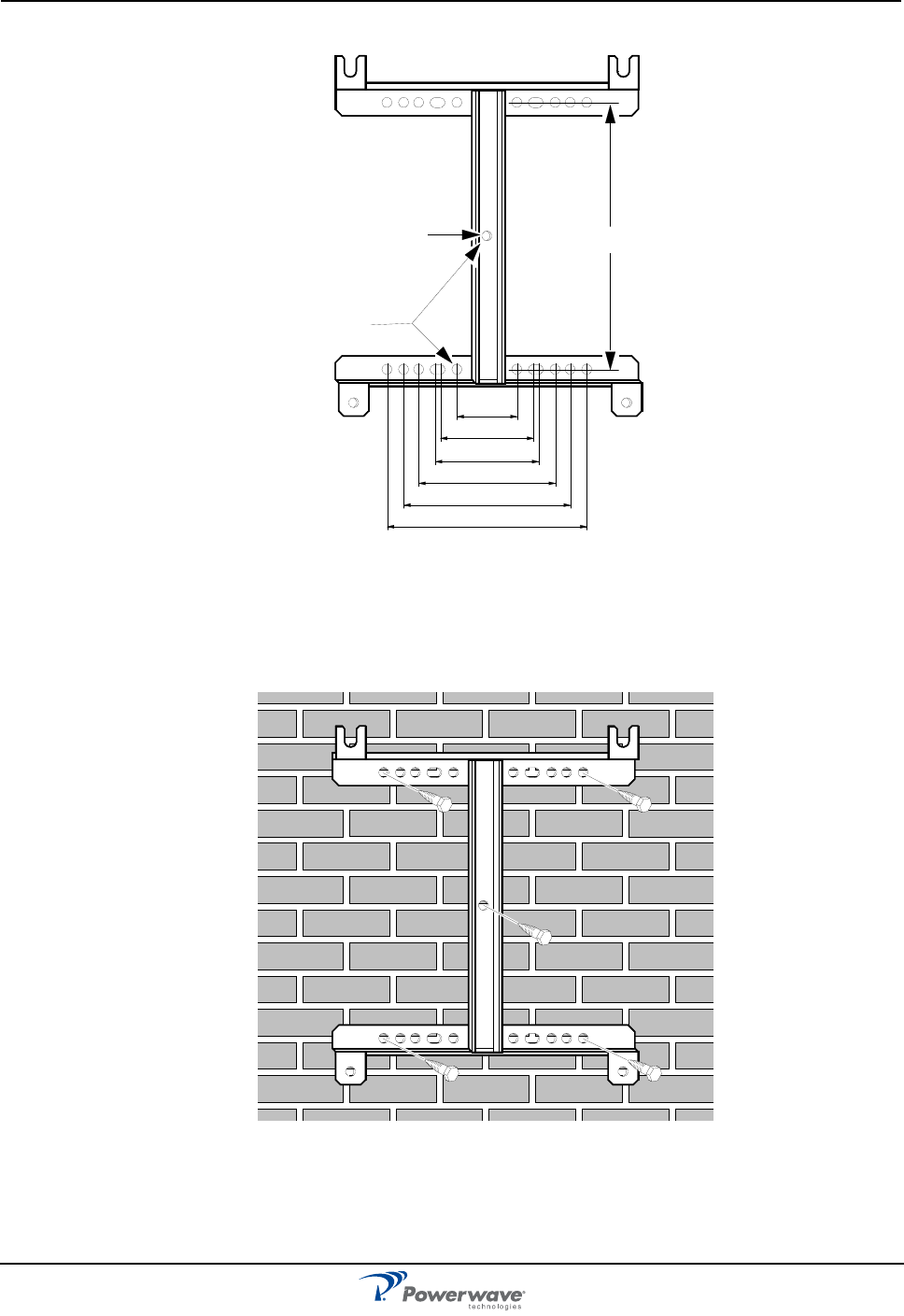
Mounting High Power Wideband Radio Head (WRH-V)
3-2 044-05251 Rev B
Figure 3-1 Mounting Bracket
Normally, the WRH-V is mounted on a wall, pole, or mast. Figure 3-2 illustrates the installation of the
mounting bracket on a wall using four fixing screws and a locking screw.
Figure 3-2 Mounting Bracket Installation on Wall
Figure 3-3 illustrates the installation of the mounting bracket on a pole using two 5.7-inch (144mm) U-shaped
clamps and a locking screw.
90
135
144
205
250
300
Ø14
A411
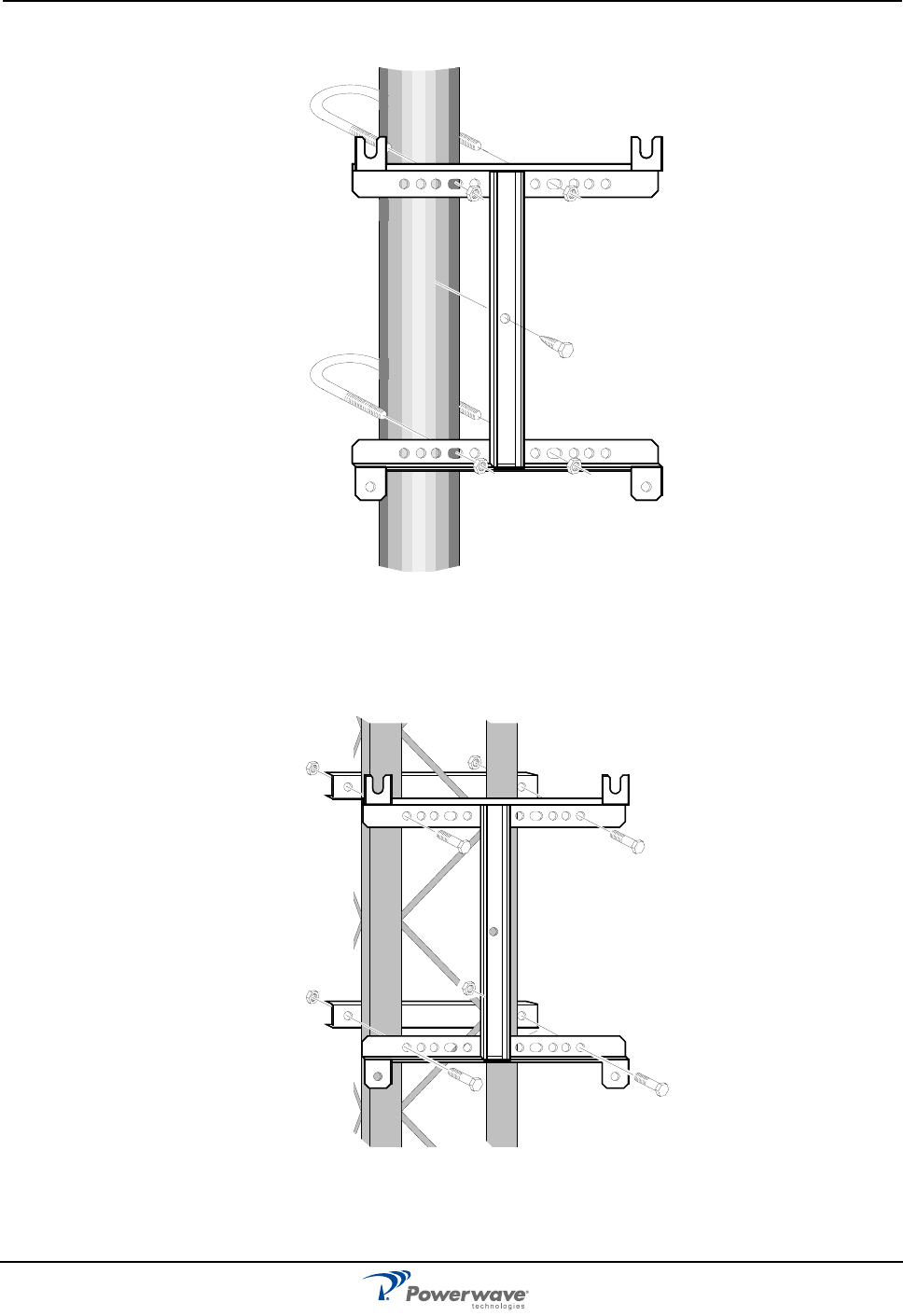
High Power Wideband Radio Head (WRH-V) Mounting
044-05251 Rev B 3-3
Figure 3-3 Attaching the Bracket to a Pole
Figure 3-4 illustrates a mast installation using two 11.8-inch (300mm) bar-shaped clamps and no locking
screw.
Figure 3-4 Attaching the Bracket to a Mast
After installing the mounting bracket, hang the WRH-V on the upper supports, as illustrated in Figure 3-5.
Tighten the upper and lower mounting screws to secure it into place using the 6mm hex socket wrench.
Locking cylinders, used to prevent unauthorized removal of the repeater, can be inserted and locked with a
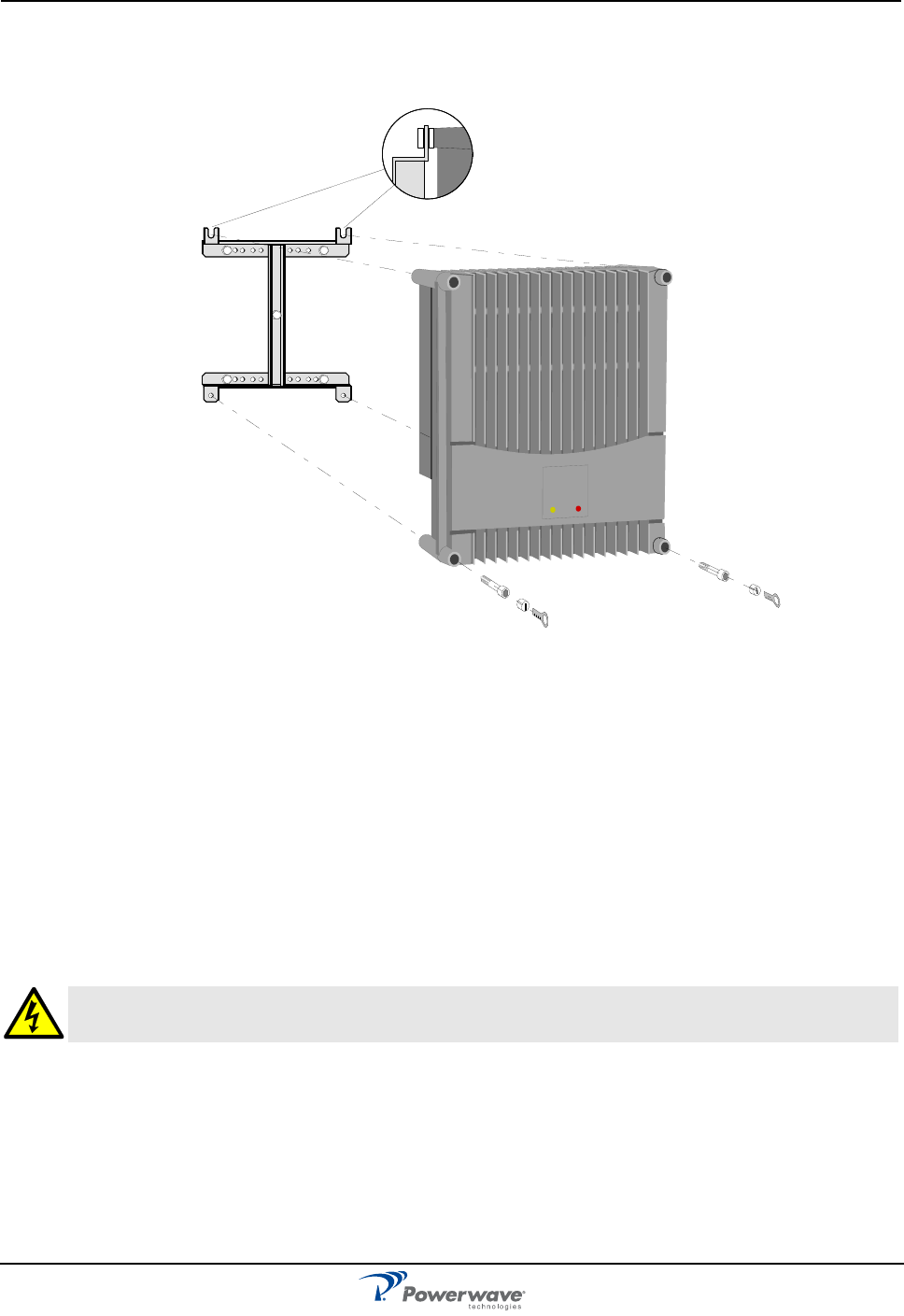
Connections High Power Wideband Radio Head (WRH-V)
3-4 044-05251 Rev B
key after the lower screws have been tightened. Make sure the donor antenna, directed towards the BTS
antenna, and the service antenna, directed towards the area to be covered by the WRH, are mounted and
installed properly.
Figure 3-5 Attaching the WRH-V to the Bracket
Connections
This section describes general examples of how to connect the input and output ports on the WRH.
Main Power and Grounding
Local regulations need to be followed for the main power connection. WRH-Vs are approved in accordance
with EN and UL/cUL regulations. This is, however, only valid if a classified power cord is used. For the WRH-
V to meet these regulations you must select one of the following classified and approved cord types:
❑ EN – H 05 W5 - F HMR
❑ UL – AWM Style 2587
❑ CSA– AWM 1 A/B 11 A/B
For outdoor use, the power cord should meet at least IP65 encapsulation requirements. Do not turn the main
power on until you are ready to commission the WRH.
Fiber Optic and RF Connections
Fiber optic and RF cable connections should be verified both internally and externally before powering up the
equipment. This section illustrates the general internal connections of the WRH-V. Verify these connections
with the as-built drawings and documents for your specific system configuration. Table 3-1 lists the steps to
add the external connections to the WRH-V.
WARNING: For WRH-Vs supplied from the main power source, the main outlet must be
grounded.
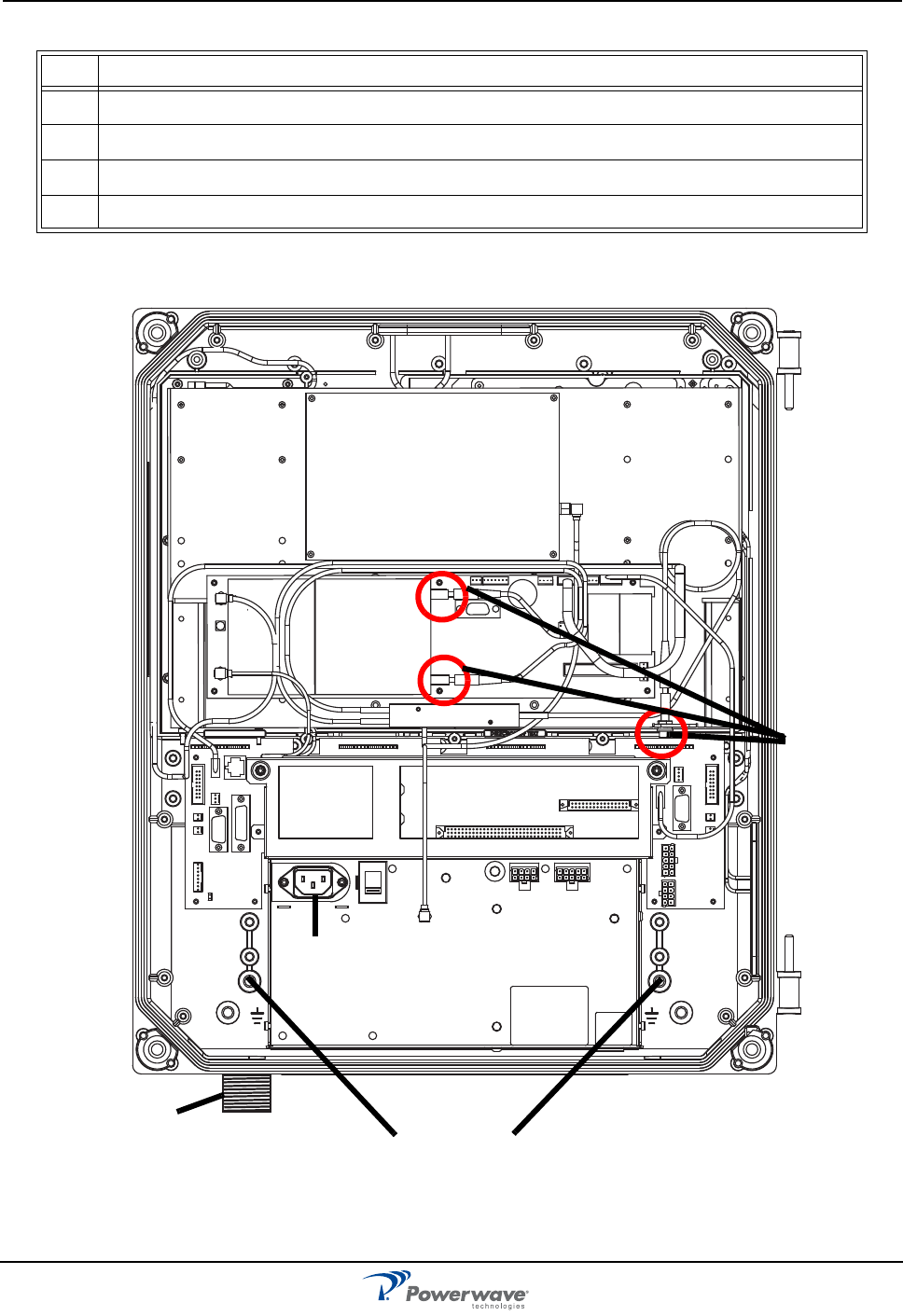
High Power Wideband Radio Head (WRH-V) Connections
044-05251 Rev B 3-5
Table 3-1 Cable Connection Procedure
WRH-V
Figure 3-6 illustrates the cables and connections for the WRH-V.
Figure 3-6 WRH-V Cable Connections
Step Action
1 Connect service antenna coaxial cable to left-outside DIN connection on cabinet
2 Connect fiber optic cable from OCM or BMU to fiber optic cable demark on FOU
3 Connect station ground to appropriate ground point in cabinet
4 Mount main power plug to main power cord and insert into PSU
1550
1310
Power connection
Fiber Optic
(laser)
Connections
Service Antenna
Connection Ground Points
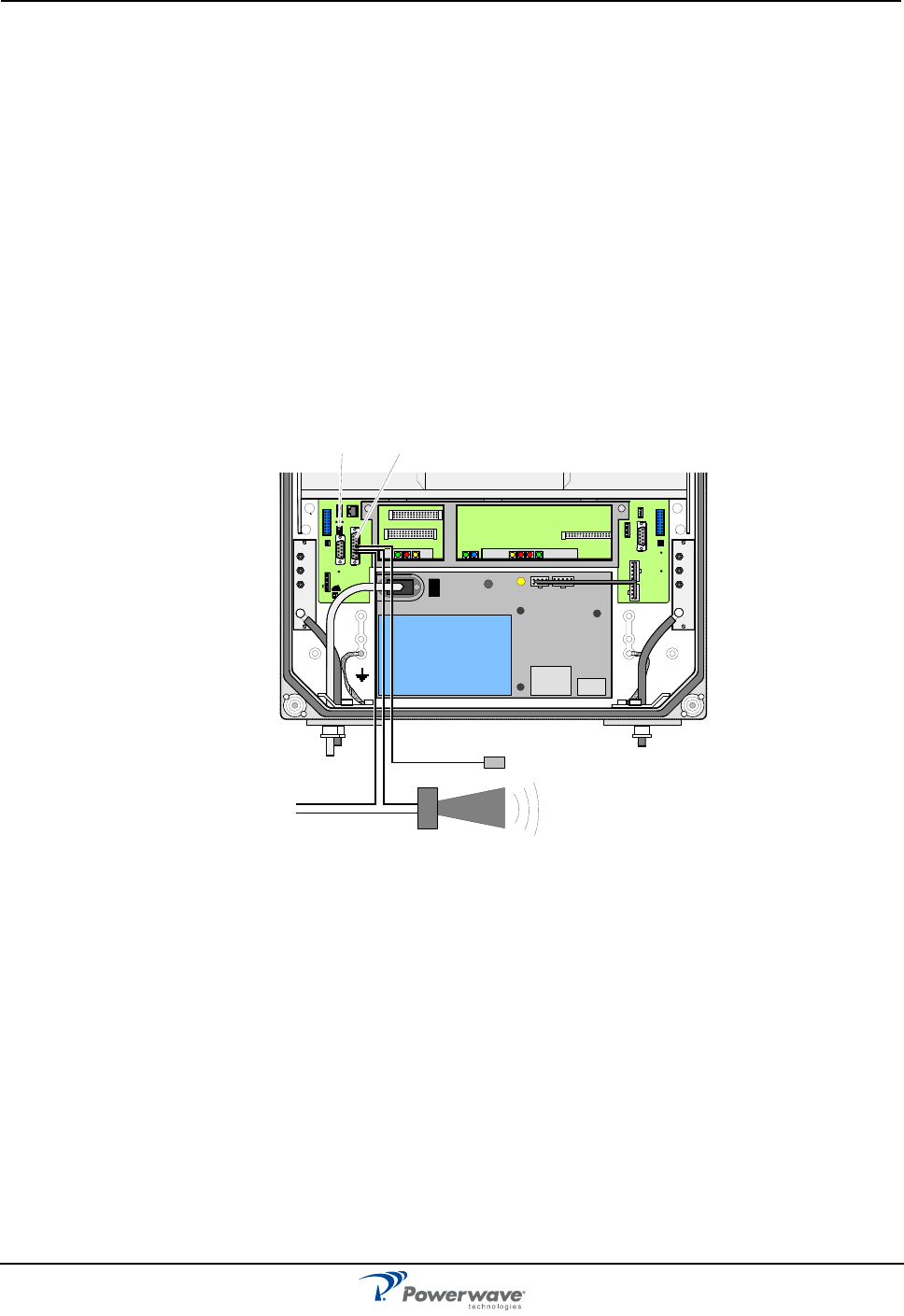
Optional Connections High Power Wideband Radio Head (WRH-V)
3-6 044-05251 Rev B
Optional Connections
Alarms
Alarm signals from external sensors are received by an ALI or RCI which forwards them to the CU. The RCI is
used if the WRH-V has an RCU, otherwise the ALI is used. The software on the CU can activate acoustic or
visual alarms or direct the alarm to the P33 alarm port for forwarding via an RCU through OM-Online. Alarms
can also be handled by the FON. Alarms are configured through OM-Online.
External Alarm
Burglary, fire or other external alarms can be handled by the WRH-V. External alarm sensors and alarm
signals are connected to the P33 alarm port located to the left in the cabinet, as illustrated in Figure 3-7. The
P33 alarm port is described in Chapter 2. The cable for this installation is taken through a strain relief bushing
at the bottom of the WRH-V cabinet.
Door Open Alarm
A door open alarm can be configured and installed in the WRH. This is arranged with a door switch connected
to pin 8 (AI4) on P28, as described in chapter 2. The location of P28 is shown in Figure 3-7.
Figure 3-7 External Alarm Connection
Main Power Breakdown Relay
To be able to distinguish PSU faults from power failures, a main power breakdown relay can be used. This
relay is not included in the WRH. It has to be mounted outside the WRH-V cabinet. The relay intended for this
purpose must fulfil the following specifications:
Closing time: Max. 30 milliseconds
Insulation coil/contact: Min. 4KV
A main power connected relay must also be in compliance with valid local regulations. To install a main power
breakdown relay connection, follow the steps listed in Table 3-2.
MS
DPX
ANT
TEST
DC
-30 dB
-20 dB
MS
DPX
ANT
TEST
DC
-30 dB
-20 dB
POWER SUPPLY UNIT
ALLGON INNOVATION
SWEDEN M105 R6
1
PARKING
FOR W5
W5
8
P27 W6B 10
1
P33
ALARM
P23
LNA
UP-LINK
P32
MODEM
AUX1
P28
DOOR
5
9
61
116
1
1
M->S
P11
P34
8
9
15
P26
15 16
S->M
12
389
P36
5
X0A
X0B
2V2 116
P12 P13
1
1
1
16
16
16
P4
P5
P6
c
b
a
c
b
a
c
b
a
c
b
a
1P232
1
b
a
116P3
16 116
P14
1
V1
1
1
1
1
1
4
6
1
15
6
915
2
16
1
2
4
5
8
5
P35
P21
PSU
6
10
P31
PC
P29
P24
P25
GND
7
6V6
LNA
DOWN-LINK
LED
P22
1
2
P28 P33
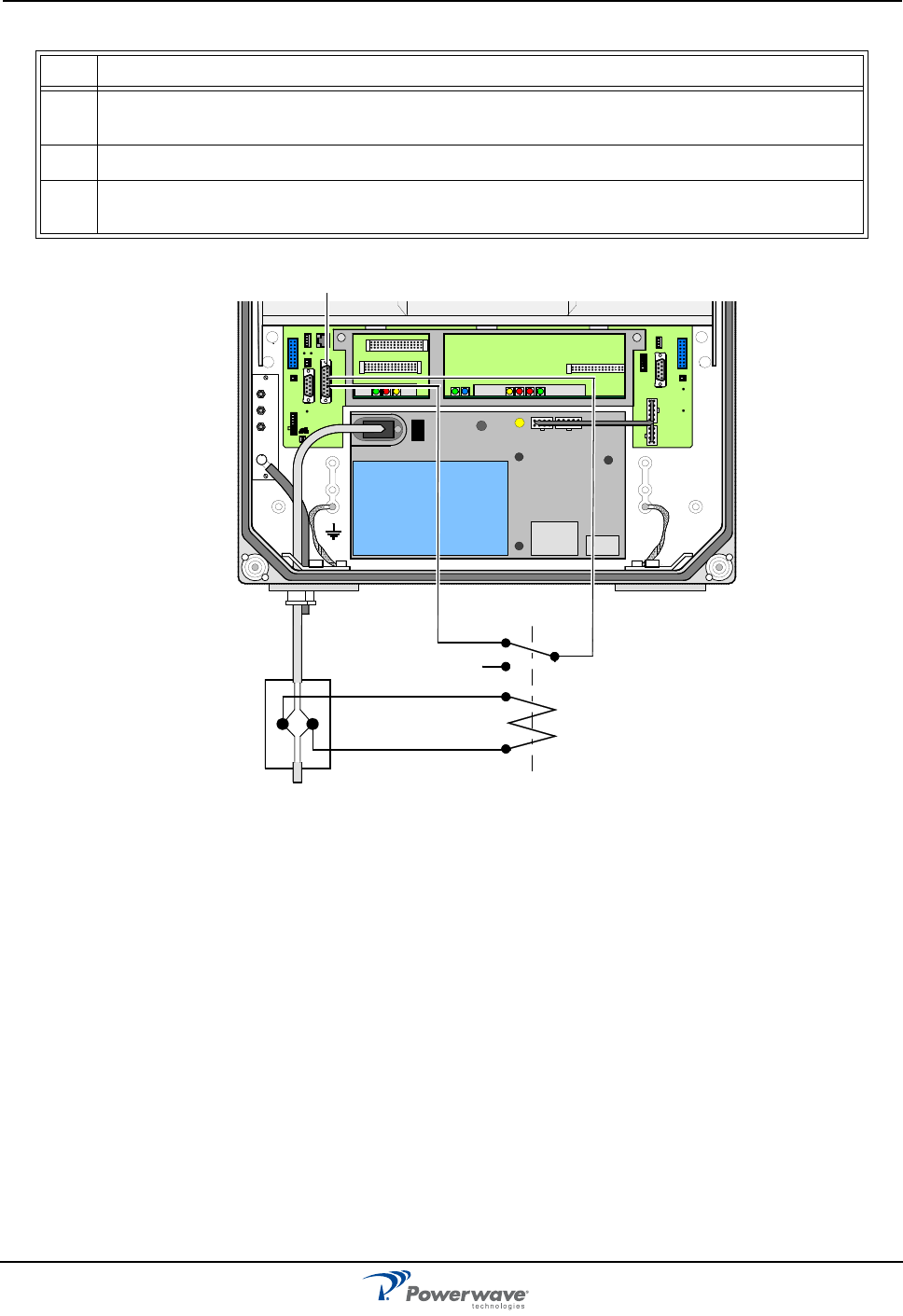
High Power Wideband Radio Head (WRH-V) Commissioning
044-05251 Rev B 3-7
Table 3-2 Main Power Breakdown Relay Connection
Figure 3-8 Main Power Breakdown Relay Connection
21-60 Volt DC PSU Installation
See the Field Replaceable Units, PSU section in Chapter 4 for details on replacing a 115/230 VAC PSU with
a 21 to 60 Volt DC PSU.
Commissioning
Before proceeding, carefully read the Safety section and check all connections made during the installation.
To fulfill the IP65 weather protective requirements, ensure cable strain relief bushings are properly tightened.
Also, ensure gaskets at cable inlets and on the cabinet are properly fitted and not damaged.
Step Action
1 Connect a currentless closed relay contact to pin AI1 and AIC on P33 alarm connector, as shown in
Figure 3-8. Alarm is initiated when pins AI1 and AIC are shorted
2 Connect relay coil. Coil must be supplied from same fuse as WRH
3 After commissioning, select Mains Breakdown in alarm configuration window in OM-Online. For
details on setting alarm configuration see OM-Online User Manual.
MS
DPX
ANT
TEST
DC
-30 dB
-20 dB
POWER SUPPLY UNIT
ALLGON INNOVAT ION
SWEDEN M105 R6
1
PARKING
FOR W5
W5
8
P27 W6B 10
1
P33
ALARM
P23
LNA
UP-LINK
P32
MOD EM
AUX1
P28
DOOR
5
9
61
116
1
1
M->S
P11
P34
8
9
15
P26
15 16
S->M
12
389
P36
5
X0A
X0B
2V2 116
P12 P13
1
1
1
16
16
16
P4
P5
P6
c
b
a
c
b
a
c
b
a
c
b
a
1P232
1
b
a
116P3
16 116
P14
1
V1
1
1
1
1
1
4
6
1
15
6
915
2
16
1
2
4
5
8
5
P35
P21
PSU
6
10
P31
PC
P29
P24
P25
GND
7
6V6
LNA
DOWN-LINK
LED
P22
1
2
P33:AICP33:AI1
P33
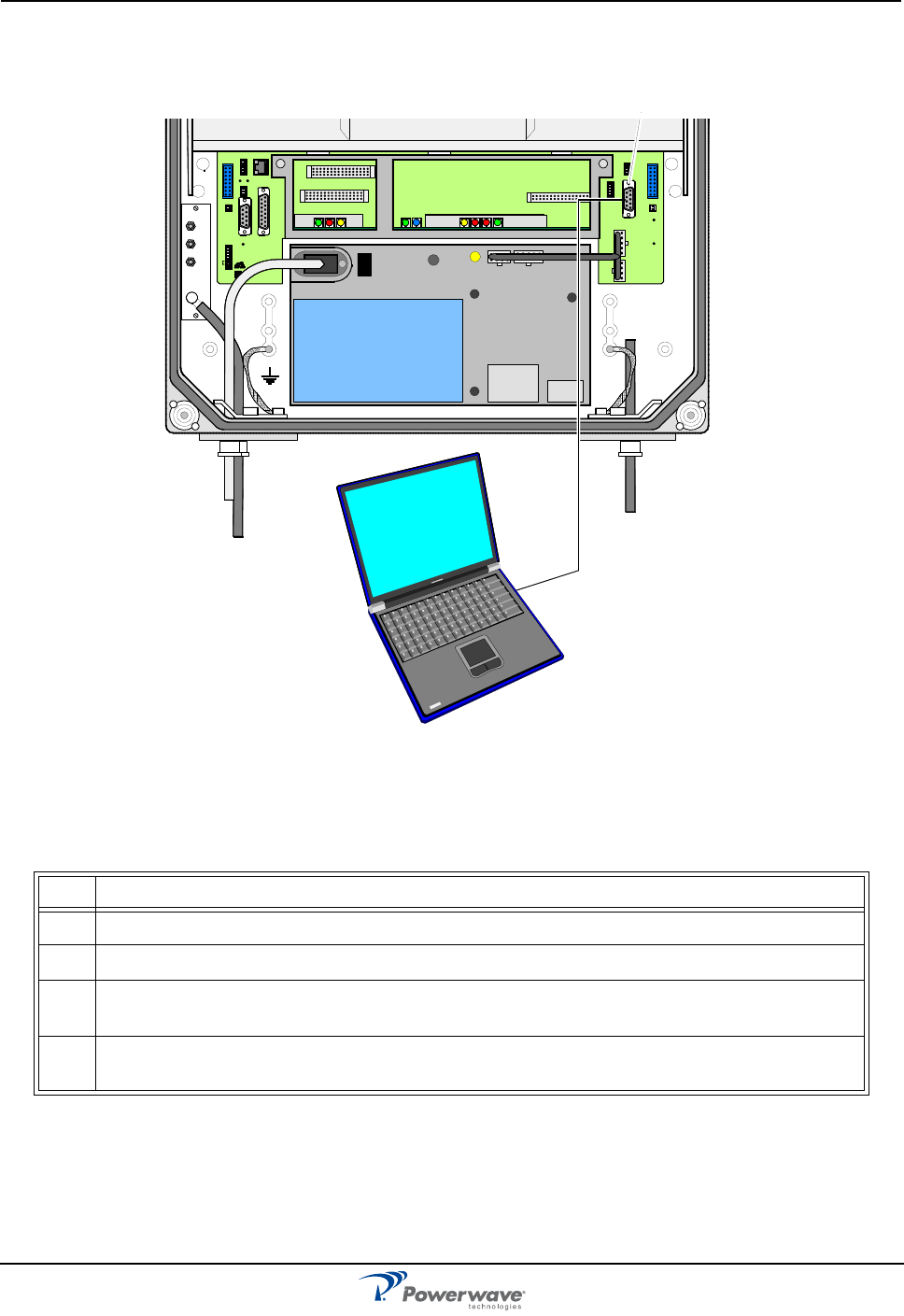
Commissioning High Power Wideband Radio Head (WRH-V)
3-8 044-05251 Rev B
A WRH-V can be configured locally with OM-Online by connecting a standard serial cable from the COM port
on the PC to the P31 PC port (RS-232) located to the right in the cabinet as shown in Figure 3-9. The P31 PC
port is described in Chapter 2. Details on using OM-Online are described in the OM-Online User Manual.
Figure 3-9 Connecting a PC for Local Access
Initial Startup
To complete the inital start-up of the WRH-V, follow the steps listed in Table 3-3.
Table 3-3 Initial Statup Procedure
Step Action
1 Turn main power on
2 Check Yellow LED on power supply unit. Steadily lit = functioning correctly
3 Check the four CU PCBA LEDs. Refer to CU PCBA section in Chapter 2 for correct power up
indications
4 Check the three ALI PCBA LEDs or corresponding LEDs on RCI PCBA. Refer to ALI or RCI PCBA
section in Chapter 2 for correct power up indications
MS
DPX
ANT
TEST
DC
-30 dB
-20 dB
POWER SUPPLY UNIT
ALLGON I NNOVATION
SWEDEN M105 R6
1
PARKING
FOR W5
W5
8
P27 W6B 10
1
P33
ALARM
P23
LNA
UP-LINK
P32
MODEM
AUX1
P28
DOOR
5
9
61
116
1
1
M->S
P11
P34
8
9
15
P26
15 16
S->M
12
389
P36
5
X0A
X0B
2V2 116
P12 P13
1
1
1
16
16
16
P4
P5
P6
c
b
a
c
b
a
c
b
a
c
b
a
1P232
1
b
a
116P3
16 116
P14
1
V1
1
1
1
1
1
4
6
1
15
6
915
2
16
1
2
4
5
8
5
P35
P21
PSU
6
10
P31
PC
P29
P24
P25
GND
7
6V6
LNA
DOWN-LINK
LED
P22
1
2
P31
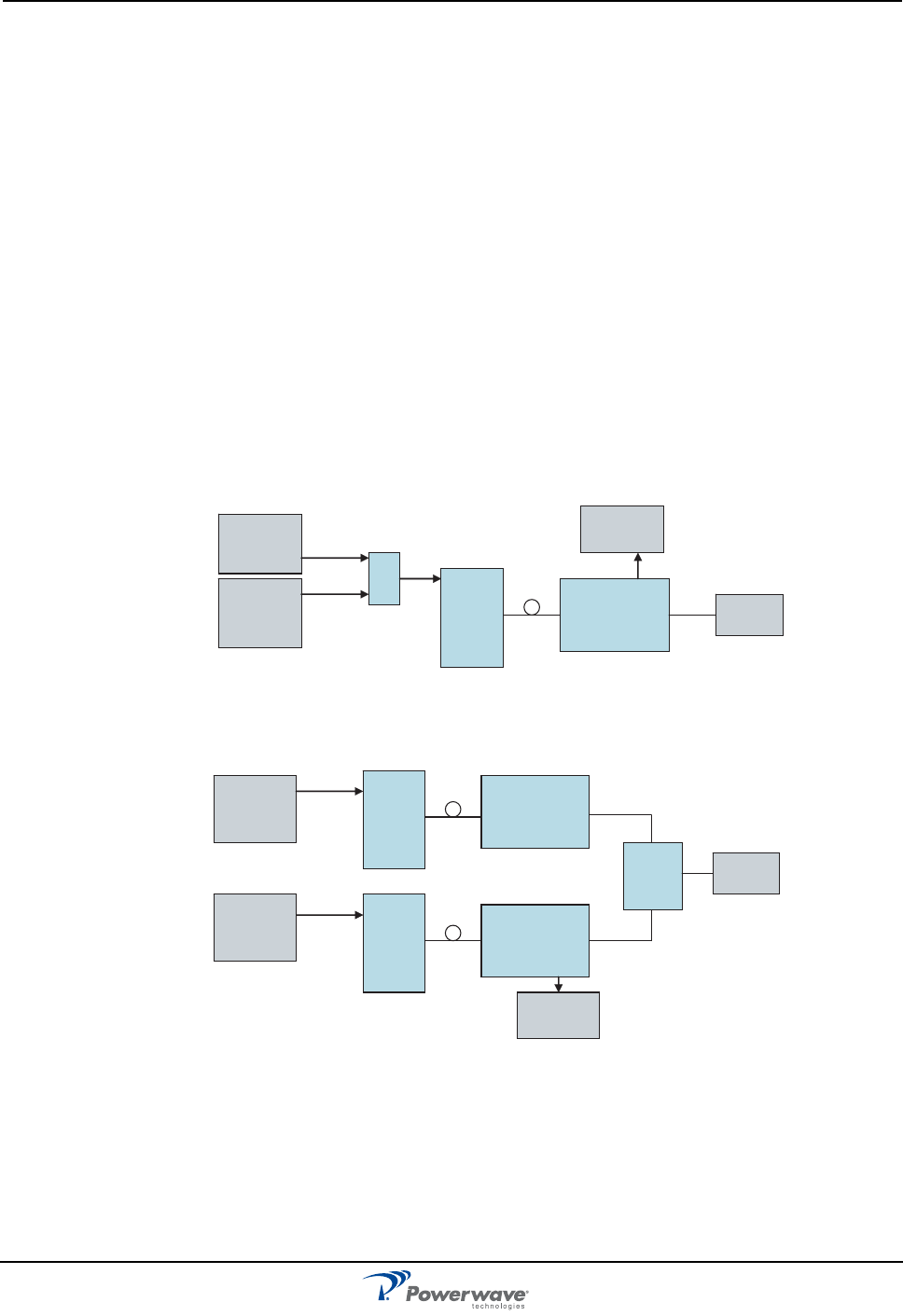
High Power Wideband Radio Head (WRH-V) Commissioning
044-05251 Rev B 3-9
Passive Intermodulation (PIM) Testing
PIM is the non-linear effect of passive RF components in a desired RF transmission band. As higher per-
carrier transmit power levels are applied to duplexed passive RF networks, PIM becomes an increasingly
significant factor in potential receiver desensitization. A PIM tester may be used on the RF network prior to
turn-on and commissioning of the unit, but if a PIM tester is not available, the following may be used:
The following equipment is required to test for PIM:
❑ Anritsu Site eMaster or equivilent RF Spectrum Analyzer
❑ Agilent ESG4432B or equivilent Multi-Signal Generator (or commissioned BTS)
❑ Guarateed/calibrated PIM load capable of handling 20W composite power
❑ Low-PIM RF cable adaptors such as N-N female, Din male to N femaile, DIN-DIN, SMA-SMA
female, and N male to SMA female
❑ Installed and operational WRH-V unit
❑ Installed passive RF network under test
❑ Torque wrenches for DIN and N connectors
Two different types of setup are available, depeding on equipment availability and testing methods.
Figure 3-10 shows PIM testing with two carriers over one WRH-V, and Figure 3-11 shows PIM testing with
one carrier over each of two WRH-Vs.
Figure 3-10 PIM testing two carriers and one WRH-V
Figure 3-11 PIM testing one carrier over each of two WRH-Vs
The following PIM test uses the receive sensitivity and gain of the WRH-V under test to verify that the receive
path is free of PIM noise. For PIM to be a problem at a particular site, TX signals must exist such that their
products fall into the RX band using the formulae:
3rd order product = (2 * f1) - f2
and
3rd order product = (2 * f2) - f1
WRH-V
E4432B
SIG Gen
(
or BTS
)
E4432B
SIG Gen
(or BTS)
Load /
DAS
Σ
OCM
E4402B
Spec. An.
WRH-V
Under Test
E4432B
Sig Gen /
BTS 1
Load /
DAS
OCM
E4402B
Spec. An.
WRH-V
Hybrid
OCM
E4432B
Sig Gen /
BTS 2

Commissioning High Power Wideband Radio Head (WRH-V)
3-10 044-05251 Rev B
Where f1 and f2 are two TX signals entering a WRH-V. The specification for the maximum allowed PIM is -115
dBm per 100 kHz resolution bandwidth at rated output power. To test for PIM follow the steps listed in
Table 3-4.
Table 3-4 PIM Testing Procedure
Step Action
1 If BTS signals are present, continue with step 2. Otherwise, connect two signal generators to OCM
and set frequencies such that products are in relevent receive band (see equations above)
2 Set WRH-V UL gain to 60 dB and DL gain such that desired per carrier power is presented at output
port
3 Set Spectrum Analyzer to 100 kHz resolution bandwidth and view RX band at 3rd order product
frequency calculated in step 1
4 Loosen fastening screw in each corner on front cover of WRH-V under test, and open cover
5 Verify the noise floor specification for the Spectrum Analyzer. If the noise floor is higher than or equal
to -85 dBm/100 kHz, locate FON, disconnect UL cable from port P101 and connect
SpectrumAnalyzer to the cable using an SMA female - female connector (noise limit becomes -115
dBm + 60 dB = -55 dBm). Continue with step 7.
6 If noise floor is lower than -85 dBm/100 kHz, locate the FON card and connect the Spectrum Analyzer
to P117 (noise limit becomes -115 dBm + 60 dB - 30 dB = -85 dBm). If the FON only has three RF
ports on the left side, port P117 will not be available, so follow instructions listed in step 5.
7 Enable WRH-V TX signal. For details on using OM-Online, see OM-Online user manual
8 Using Spectrum Analyzer, measure noise level. If no noise exists above calculated limit in step 5
(-55 dBm) or step 6 (-85 dBm) above, as appropriate, then test is passed and no other action is
necessary
9 If a higher level of noise exists, disable the WRH-V TX signal and disconnect cable to DAS at bottom-
left outside corner
10 Connect low PIM load onto WRH-V Service antenna connector at bottom-left outside corner. Tighten
connectors securely
11 Remeasure noise level. If no noise exists above calculated limit in step 5 (-55 dBm) or step 6 (-85
dBm) as appropriate, then DAS has a PIM issue. Tighen all connections in DAS with torque
wrenches, replace any cripmed or severely bent cables, and retest. Repeat until all issues are solved
12 Otherwise, if noise is higher than limit, WRH-V is defective and must be replaced. See Chapter 4 for
Replacement procedures

044-05251 Rev B 4-1
Chapter 4
Maintenance
Introduction
This chapter contains periodic maintenance and performance test procedures for the WRH.
Periodic Maintenance
Periodic maintenance requirements are listed in Table 4-1, as well as the intervals at which the tasks should
be performed.
Troubleshooting
The sections that follow contain a list of problems that could occur and a few suggested actions that might
correct each problem. If the suggested corrective action does not eliminate the problem, please contact your
Powerwave field representative or help line for further instruction.
Clearing Alarm Faults
Table 4-2 lists the alarms that can be generated in the WRH. Critical, Error and Warning alarms are sent
automatically from a WRH-V to OM-Online, stored and then viewed in the Alarm window.
Table 4-1 Recommended Periodic Maintenance
Task Interval Action
Inspection of cables
and connectors
12 months Inspect power, RF and Fiber cables for signs of damage or wear
(frayed insulation, cracks, punctures, etc.) Check connections to be
sure they are tight
Optional Perform cable sweeps
Clean equipment Clean as required depending on operating environment
Table 4-2 Alarm Troubleshooting
ID Alarm Text Alarm Unit Alarm Description
1 Power PSU Critical PSU1 in the cabinet does not work properly. A sum signal from
the PSU1 indicates that at least one voltage output has dropped. If
no mains breakdown relay is used, then the alarm will also be sent
at mains breakdown
Ceasing PSU1 in the cabinet works properly again. Ceasing is sent if the
PSU1 works at start-up, and there is a corresponding critical
PSU1 alarm logged in the Events log. The WRH-V will restart
when the power is back and this alarm will be sent
PSU Critical PSU2 in the cover does not work properly. A sum signal from the
PSU2 indicates that at least one voltage output has dropped. If no
mains breakdown relay is used, then the alarm will also be sent at
mains breakdown

Troubleshooting High Power Wideband Radio Head (WRH-V)
4-2 044-05251 Rev B
Ceasing PSU2 in the cover works properly again. Ceasing is sent if the
PSU2 works at start-up, and there is a corresponding critical
PSU2 alarm logged in the Events Log. The WRH-V will restart
when the power is back and this alarm will be sent
Power FON Error The FON 10 Volt charger voltage is below limit. Suggested
remedy: Replace the FON
Ceasing The cause of the alarm has ceased
2 WRH-V
restart
CU None Power on start, or user ordered reboot. Logged to indicate a
normal power up, or a restart ordered by the operator
Warning Software error restart, 1st – 7th time. Restart 1st to 7th time during
a 14 day period. The counter is reset every 14th day, counted
from power up
Error Software error restart 8th – 10th time. Restart 8th to 10th time
during the 14 day period. At the 11th time, the SW bank will be
blocked and not used anymore until a user ordered reset is
performed, or power is switched off/on
3Mains
breakdown
External Critical The mains power is gone. Used with an external relay indicating
mains breakdown. The external relay should be connected to
External Alarm 1 and the WRH-V configured to indicate this alarm.
If no relay is used, a mains breakdown will be reported as a PSU
fault
Ceasing The mains power is back. Sent if there is a corresponding critical
mains breakdown alarm logged in the Events Log. The WRH-V
will restart when the power is back
4 Alarm reset CU None Alarm reset by the user. All alarms are reset. The cause of the
alarm will be re-evaluated and reported, if still active
5 Local bus
error
WBA #,
MCPA#
Error Error when communicating on the bus. The CU has no contact
with the WBA, or MCPA PCBA, which is taken out of service
6 Main bkd w
backup
External Error Used to indicate that the mains is no longer available. WRH-V is
powered by external battery backup unit. Suggested remedy:
Check the mains power
Ceasing The cause of the alarm has ceased
7Err in AD-
converter
Warning The analog-to-digital converter on the CU PCBA does not give
reliable values
8 New unit
detected
None Compared to the last power on, the CU has recognized at least
one additional hardware unit
9 Inst. unit lost Error Compared to the last power on, the CU lacks at least one
hardware unit
10 EEPROM
error
CU Error EEP read or write fail. Data cannot be written or read from the
EEPROM on the CU PCBA. User parameters are stored in the
EEPROM
11 Log memory
fault
Error Log memory fault. Indicates that the log memory on the CU PCBA
is faulty. The WRH-V will not work. Not available in all CU
software versions
Table 4-2 Alarm Troubleshooting (Continued)
ID Alarm Text Alarm Unit Alarm Description

High Power Wideband Radio Head (WRH-V) Troubleshooting
044-05251 Rev B 4-3
12 High temp CU Warning The CU PCBA temperature is higher than 90°C
Ceasing The CU PCBA temperature has fallen below 90°C
13 REFO error Error Significant REFO drift or error detected by CU
14 Ext REFO
error
Warning Suggested remedy: Check the reference source and the cables
15 CU battery
fault
CU Warning CU RAM battery fault. The battery for the RAM on the CU PCBA
has a voltage outside the normal 2.7 to 3.5 Volt. An alarm may be
initiated at start-up if the WRH-V has been stored out of power for
a long time. Suggested remedy: Ensure jumper P3 on the CU
PCBA is mounted to charge the battery
Ceasing The cause of the alarm has ceased
16 SW load error CU Error Software load error. An error has occurred during a software load
process. The flash memory does not contain a proper software.
Suggested remedy: Check the CU software using the OM-Online
SW Manager. Do NOT restart the WRH
17 Log cleared CU None Log memory has been cleared. The check sum in the Events Log
memory is faulty. The log is cleared. Can be caused of a bad RAM
battery backup or low voltage to the RAM
18 RTC restarted CU None The time is changed by the operator (logged to keep track of
changes made to the RTC)
Warning Time reset to 1994-01-01. The RTC was unable to keep track of
the time and did a reset. Suggested remedy: Ensure jumper P3 on
the CU PCBA is mounted to charge the battery
19 RTC error Error RTC does not operate. The CU has detected an error in the RTC
operation which makes the time unreliable. Suggested remedy:
Replace the CU PCBA
20 Door open
alarm
External Config The door has been open 30 seconds without disabling the alarm
Ceasing The door has been closed 30 seconds, or the alarm is disabled
21 External
alarm 1
External Config External alarm input EA1 active more than 1 second
Ceasing External alarm input EA1 no longer active
22 External
alarm 2
External Config External alarm input EA2 active more than 1 second
Ceasing External alarm input EA2 no longer active
23 External
alarm 3
External Config External alarm input EA3 active more than 1 second
Ceasing External alarm input EA3 no longer active
24 External
alarm 4
External Config External alarm input EA4 active more than 1 second
Ceasing External alarm input EA4 no longer active
Table 4-2 Alarm Troubleshooting (Continued)
ID Alarm Text Alarm Unit Alarm Description

Troubleshooting High Power Wideband Radio Head (WRH-V)
4-4 044-05251 Rev B
30 No modem
found
Remote ctrl None No modem found, that is no answer is returned on a poll string to
the modem
33 No
connection
Remote ctrl None No connection at callback. The WRH-V has tried to call as many
times as stated in the alarm call settings. No connection was
established.
Warning No connection at alarm call. The WRH-V has tried to call as many
times as stated in the alarm call settings. No connection was
established. This alarm does not generate a new attempt to report
alarm by alarm call.
34 Login failed None Invalid WRH-V password
35 Remote
connection
Remote ctrl None Modem connection to OM-Online opened. Not logged on CU2.
Login Registry gives the same function and more information
about CU2
36 Modem init
failed
Remote ctrl None Initiation string to modem not OK. The initiation string sent to the
modem is not OK. The string may contain commands not
recognized by the modem. An alarm might be sent anyway.
Suggested remedy: Check the modem using the OM-Online or
OMS modem debugger
37 Remote
timeout
Remote ctrl Warning The time limit of 20 minutes is exceeded without extending the
timer. The modem connection is terminated by the WRH
38 PIN code
failed
Remote ctrl Warning The PIN code sent to MS is incorrect. To unlock the MS/SIM card,
the PUK code will probably be needed
Ceasing The cause of the alarm has ceased
39 No phone
detected
Remote ctrl Warning When using a PC-card together with the MS, the alarm indicates
contact with the PC-card, but MS is not present or turned off.
Note: A Nokia MS does not power-up after power failure.
Suggested remedy: Ensure the cellular phone is connected
Ceasing The cause of the alarm has ceased
40 Battery fault RCU, FON
charger
Error The backup battery on the RCU or the FON PCBA does not work
properly. Suggested remedy: Check cables or replace battery
Ceasing The cause of the alarm has ceased
42 Antenna
isolation
WBA #,
Channel #,
UL/DL
Warning Low antenna isolation. The antenna isolation is lower than the
gain set. Gain is reduced by 10dB – 13dB below the oscillation
point. Suggested remedy: Decrease gain or increase antenna
isolation
Error Low antenna isolation at lowest gain. The gain has been reduced
as much as possible but the oscillation still remains. The amplifier
is turned off. Suggested remedy: Decrease gain or increase
antenna isolation
Ceasing Normal operation again, that is no oscillation can be detected
13dB above the gain set
48 Battery
backup fault
External Error If a battery backup unit alarm is connected to external alarm 2,
then the operator can configure the WRH-V to display this alarm
when the battery backup unit indicates alarm
Table 4-2 Alarm Troubleshooting (Continued)
ID Alarm Text Alarm Unit Alarm Description

High Power Wideband Radio Head (WRH-V) Troubleshooting
044-05251 Rev B 4-5
Remarks:
The Door Open alarm requires an optional door switch described in the Door Open Alarm section of Chapter
3.
The Main power breakdown alarm requires an optional relay described in the Main Power Breakdown Relay
section of Chapter 3.
Ceasing The cause of the alarm has ceased
50 Fiberoptical
error
FOT fiber
optics
Configur
able
If a fiber unit alarm is connected to external alarm 3, then the
operator can configure the WRH-V to display this alarm when the
fiber optical unit indicates alarm
Ceasing The cause of the alarm has ceased
70 Bad table
alarm
CU Error Requested table contains incorrect information (SW error)
71 Table not
found
CU Error Requested table not found in the database (SW or calibration
error)
72 Table
database
error
CU Error Table database not found (calibration error)
80 Antenna
SWR alarm
Donor
antenna
service
antenna
Error Too low antenna return loss, caused either by cables, connectors,
or antenna problems.
Suggested remedy: Check antenna and cables
Ceasing The cause of the alarm has ceased
90 FON power
alarm
FON RF Error A DC voltage on a FON PCBA is out of range. Suggested remedy:
Replace the FON PCBA.
Ceasing The cause of the alarm has ceased
91 FON
TxStable
alarm
FON RF Error Laser transmitter control loop voltage out of range. Suggested
remedy: Replace the FON PCBA
Ceasing The cause of the alarm has ceased
92 FON RxLevel
alarm
FON Warning Received optical level is below any of the two limits (one for
Warning and one for Error). Suggested remedy: Check optical
cables
Error Received optical level is below any of the two limits (one for
Warning and one for Error). Suggested remedy: Check optical
cables
Ceasing The cause of the alarm has ceased
93 FON SPI
alarm
FON F2F Error The SPI bus connection to the RF modem does not work properly.
Suggested remedy: Replace the FON PCBA
245 Not In
Allowed Area
CU None WRH-V is moved from the operating area and the RF HW is
switched on or off
Table 4-2 Alarm Troubleshooting (Continued)
ID Alarm Text Alarm Unit Alarm Description
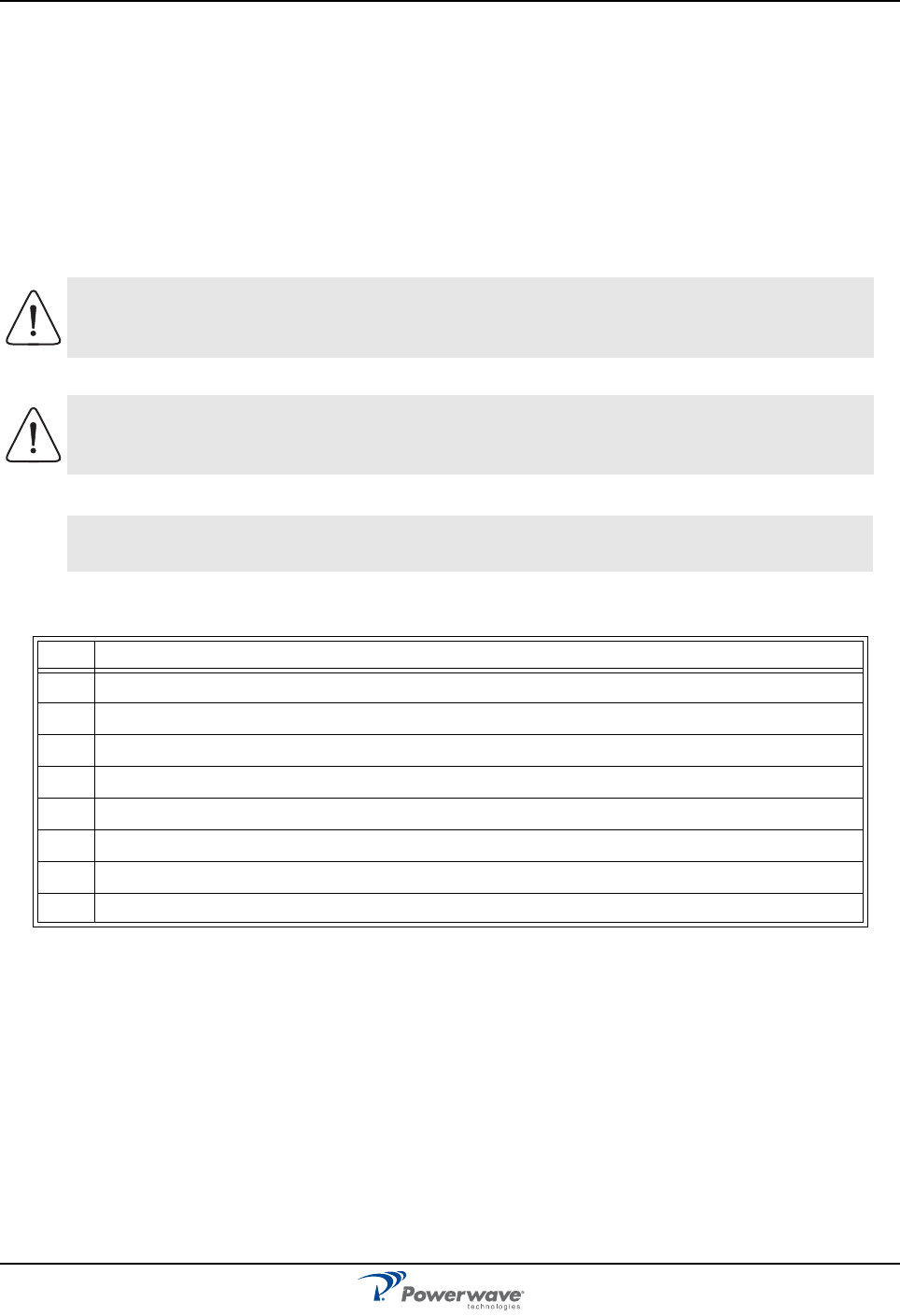
Field Replaceable Units High Power Wideband Radio Head (WRH-V)
4-6 044-05251 Rev B
Field Replaceable Units
The following units can be replaced in the field on-site by a qualified technician with experience maintaining
RF equipment:
❑ FON
❑ PSU
❑ WRH
FON
To replace a FON PCBA, follow the steps listed in Table 4-3. For details on cables and connectors, see
Chapter 2.
CAUTION: Do not look into the end of any fiber optic cable. Be sure to cap fiber optic
cables to protect the connecting end from damage
CAUTION: Use of controls or adjustments or performance of procedures other than
those specified herein may result in hazardous radiation exposure"
NOTE Verify ‘Fiberoptical’ classmark in the FON Status window is checked, otherwise FON will not be operational.
Classmarks are described in the OM-Online User Manual.
Table 4-3 FON Replacement Procedure
Step Action
1 Loosen all four locking screws on front of cabinet
2 Open WRH-V door and secure
3 Locate power connector on FON and remove connector from PCBA
4 Verify all cables on FON are labeled before disconnecting, then disconnect all cables.
5 Remove screws securing FON PCBA to FOU and remove PCBA
6 Replace FON PCBA in reverse order and apply power
7 Connect PC to OM Online port, login to FON and verify configuration and IP address.
8 Close WRH-V door and secure
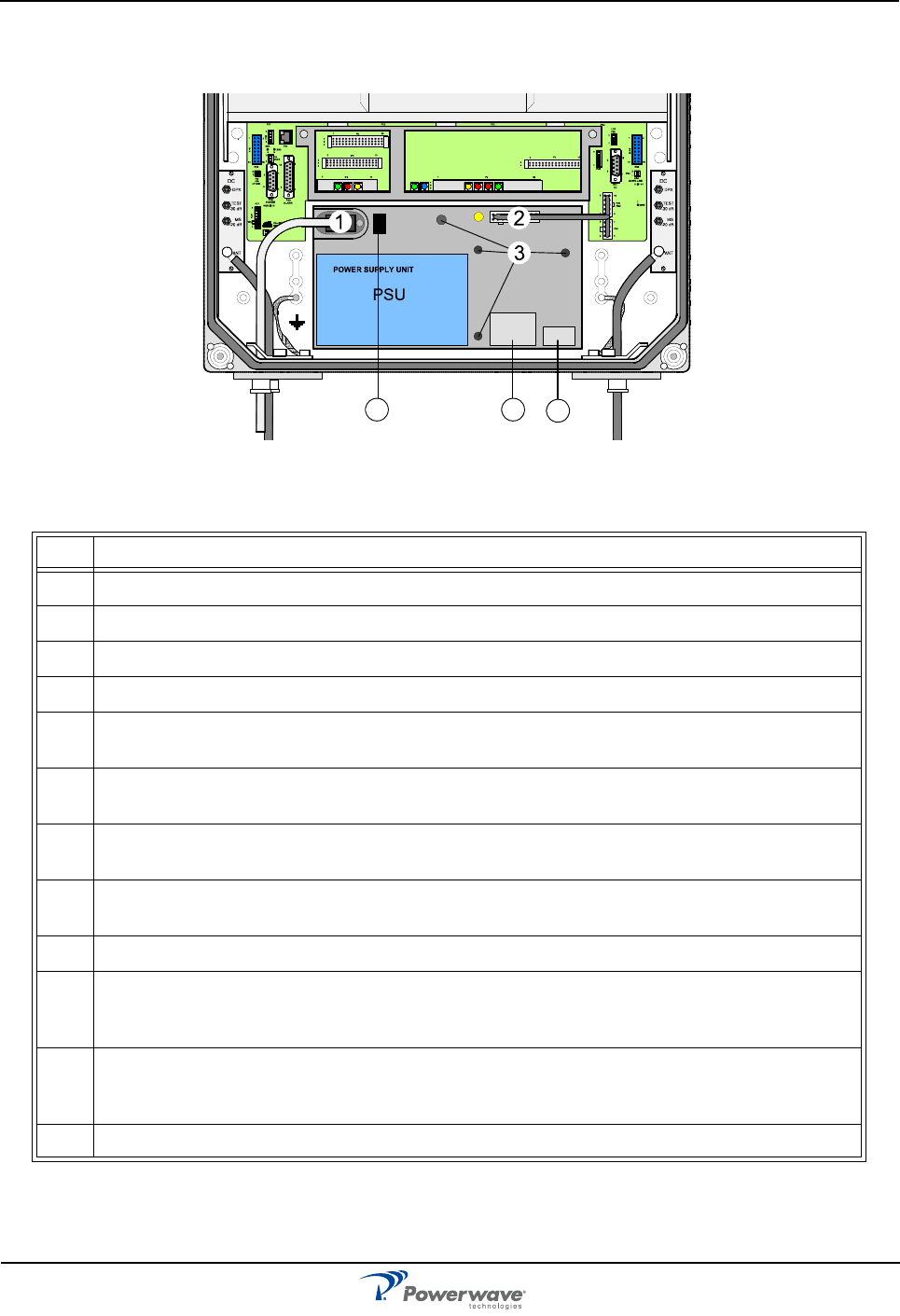
High Power Wideband Radio Head (WRH-V) Field Replaceable Units
044-05251 Rev B 4-7
PSU
To replace a PSU, follow the steps listed in Table 4-4. For details on cables and connectors, see Chapter 2.
Figure 4-1 PSU Cable, Switch and Lable locations
Table 4-4 PSU Replacement Procedure
Step Action
1 Loosen all four locking screws on front of cabinet
2 Open WRH-V door and secure
3 Disconnect main power plug from PSU(Location 1 shown in Figure 4-1)
4 Disconnect power cable bundle from PSU(Location 2 shown in Figure 4-1)
5 Loosen but do not remove screws securing PSU using a 5mm Allen key and remove PSU (Location 3
shown in Figure 4-1)
6 On new AC power supply, if used, set input voltage switch on PSU to correct input voltage -- 115 VAC
or 230 VAC (Location 4 shown in Figure 4-1)
7 On new DC power supply, if used, verify that the supply voltage is 24 VDC or 48 VDC as stated on
label on PSU (Location 5 shown in Figure 4-1)
8 Set new PSU to correct output supply voltage (27 VDC) by moving wire connection plug as illustrated
on label on PSU (Location 6 shown in Figure 4-1)
9 Mount new PSU with all four fixing screws (Location 3 shown in Figure 4-1)
10 Connect PSU to DIA PCBA (Location 2 shown in Figure 3-9) with cable marked VE007 98/1. This
cable must be used in all situations. If only one connection is available on DIA PCBA, the second
connector may be tied out of the way with a cable tie
11 Insert power cord (AC power supply) or connect DC power cable brown wire (Europe) or black wire
(US) to positive (+) pole and blue wire (Europe) or white wire (US) to negative (-) pole (DC power
supply)
12 Close WRH-V door and secure with four locking screws on front of cabinet
456
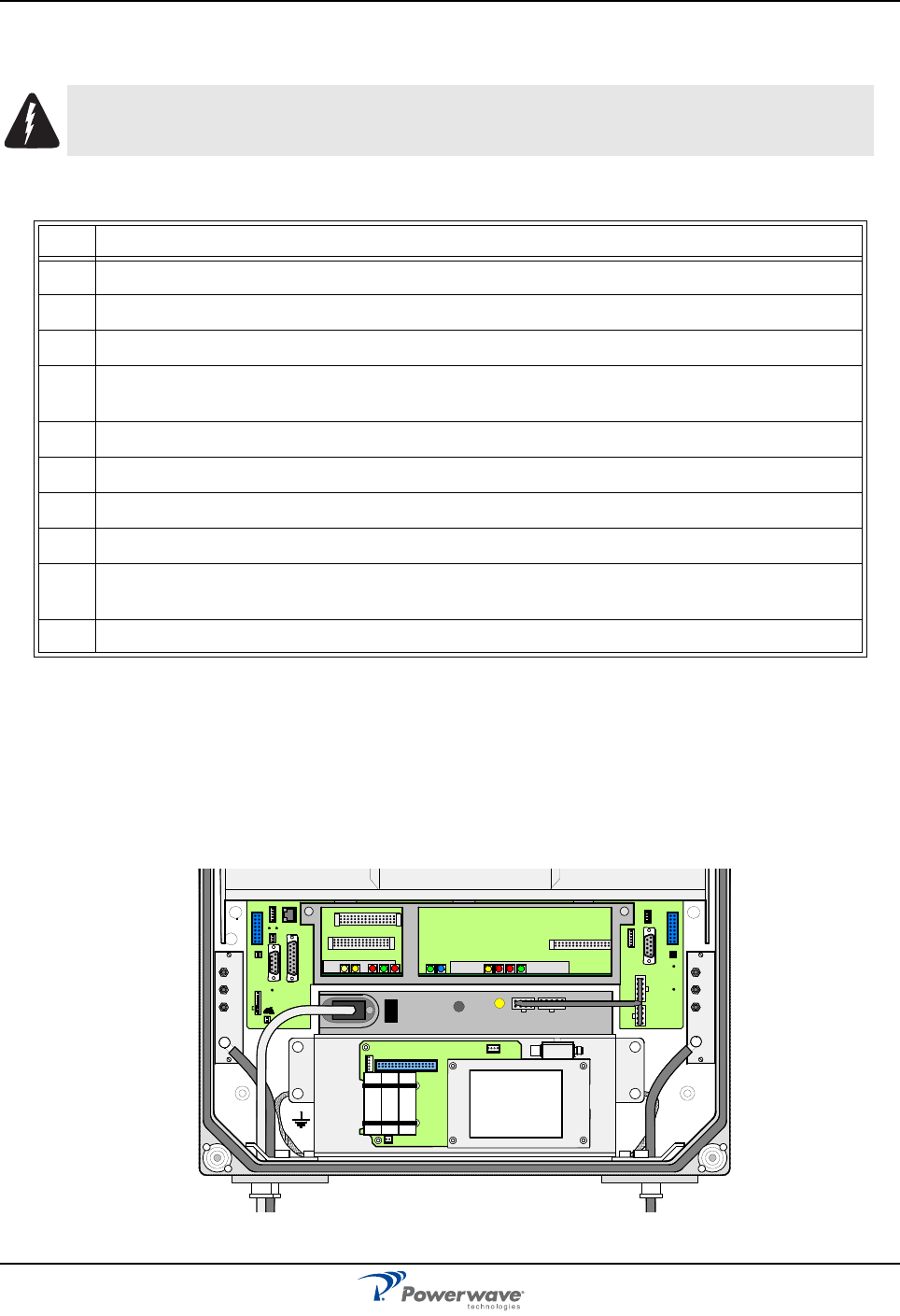
Remote Control Unit (RCU) High Power Wideband Radio Head (WRH-V)
4-8 044-05251 Rev B
WRH-V
To replace a WRH-V, follow the steps listed in the Table 4-5.
.
Remote Control Unit (RCU)
The RCU provides remote control of Powerwave WRHs. It contains an integrated mobile phone, modem and
power supply backup. The RCU is installed in the bottom front of the cabinet, on top of the PSU as illustrated
in Figure 4-2.
The RCU is connected to P130 on either an RCI or FON. A jumper is required between pins 1 and 2 on the
RCI if the P130 cable connector is disconnected. If a main power failure occurs, the unit has a battery with
enough capacity for sending a number of alarms.
Figure 4-2 RCU in the WRH-V cabinet
WARNING: A fully loaded WRH-V can weigh 96lbs. Lifting of the WRH-V should be done
by two people. Do not attempt to carry the WRH-V up a ladder.
Table 4-5 WRH-V Replacement Procedure
Step Action
1 Loosen all four locking screws on front of cabinet
2 Open WRH-V door and secure
3 Disconnect main power plug from PSU
4 Verify all external cables connected to WRH-V are labeled before disconnecting, then disconnect all
external cables
5 Remove mounting screws from bottom legs of WRH-V and loosen mounting screws in top legs
6 Close and secure door
7 Lift the WRH-V off of mount hinges
8 Replace WRH-V in reverse order
9 Connect PC to OM Online port and verify configuration. For Fiber Optic installations, verify IP
address
10 Close WRH-V door and secure
MS
DPX
ANT
TEST
DC
-30 dB
-20 dB MS
DPX
ANT
TEST
DC
-30 dB
-20 dB
ALLGON INNOVATION
SWEDEN M105 R6
1
PARKING
FOR W5
W5
8
P27 W6B 10
1
P33
ALARM
P23
LNA
UP-LI NK
P32
MODEM
AUX1
P28
DOOR
5
9
61
116
1
1
M->S
P11
P34
8
9
15
P26
15 16
S->M
12
389
P36
5
X0A
X0B
2V2 116
P12 P13
1
1
1
16
16
16
P4
P5
P6
c
b
a
c
b
a
c
b
a
c
b
a
1P232
1
b
a
116P3
16 116
P14
1
V1
1
1
1
1
1
4
6
1
15
6
915
2
16
1
2
4
5
8
5
P35
P21
PSU
6
10
P31
PC
P29
P24
P25
GND
7
6V6
LNA
DOWN-LINK
LED
P22
1
2
POWER SUPPLY UNIT
RCU

High Power Wideband Radio Head (WRH-V) Return For Service Procedures
044-05251 Rev B 4-9
RCU for Radio Communication
The RCU antenna for a radio modem is connected to the BS antenna via the uplink DC, provided the RCU
and the WRH-V operate in the same cell system. Otherwise, the modem must have a separate antenna. Data
is transferred between the WRH-V and the RCU via the P130 modem port on the RCI or FON. The RCU is
also powered via the same port and has a battery with enough capacity to send a number of alarms if a main
power failure occurs.
RCU for Telephone Line Communication
The land line version uses a telephone line connected to a terminal block on the RCU. A free strain relief
bushing at the bottom of the WRH-V is used for the external telephone line cable.
Return For Service Procedures
When returning products to Powerwave, the following procedures will ensure optimum response.
Obtaining an RMA
A Return Material Authorization (RMA) number must be obtained prior to returning equipment to the factory
for service. Pease contact our Repair Department at +1-714-466-1000 to obtain this number, or FAX your
request to +1-714-466-5800. Failure to obtain this RMA number may result in delays in receiving repair
service.
Repackaging for Shipment
To ensure safe shipment of the unit, it is recommended that the original package designed for shipping the
unit be reused. If it is not available, contact Powerwave’s Customer Service Department at 1-800-797-9283,
+1-714-466-100 or by e-mail at support@pwav.com for packing material.

Return For Service Procedures High Power Wideband Radio Head (WRH-V)
4-10 044-05251 Rev B
This page intentionally left blank

044-05251 Rev B 5-1
Chapter 5
Specifications
Introduction
This chapter provides specifications for the WRH-V.
Table 5-1 WRH-V Specifications
Electrical
Frequency band UL 824 to 849 MHz (Cellular)
806 to 824 MHz (800 iDEN)
880 to 915 MHz (GSM 900)
896 to 901 MHz (900 iDEN)
1710 to 1785 MHz (GSM 1800)
1850 to 1910 MHz (PCS)
1920 to 1980 MHz (UMTS)
1710 to 1755 MHz (AWS 2100)
Frequency band DL 869 to 894 MHz (Cellular)
851 to 869 MHz (800 iDEN)
935 to 940 MHz (GSM 900)
925 to 960 MHz (900 iDEN)
1805 to 1880 MHz (GSM 1800)
1930 to 1990 MHz (PCS)
2110to 2170 MHz (UMTS)
2110 to 2155 MHz (AWS 2100)
Max absolute delay <300 ns
Gain adjustment range (in 1 dB steps) 30 dB
Gain
Uplink
Downlink
Variation
35 to 60 dB typical - Excluding fiber link
45 to 70 dB typical - Excluding fiber link
± 1.5 dB versus temperature including fiber link
± 1.5 dB versus DL frequency including fiber link
± 0.5 dB versus DL output power including fiber link
± 0.5 dB versus input voltage including fiber link
± 2.0 dB versus UL frequency including fiber link
Instantaneous bandwidth 25 MHz (Cellular)
18 MHz (800 iDEN)
35 MHz (GSM 900)
5 MHz (900 iDEN)
75 MHz (GSM 1800)
60 MHz (PCS)
60 MHz (UMTS)
45 MHz (AWS)
Uplink AGC limit 0 dBm at FON input
Downlink AGC limit 43 dBm at antenna port
Return Loss 11 dB

Introduction High Power Wideband Radio Head (WRH-V)
5-2 044-05251 Rev B
Downlink, Spurious and Emissions level -13 dBm/1 MHz (FCC)
-36 dBm (below 1 GHz, per ETSI EN 300 609-4)
-30 dBm (above 1 GHz, per ETSI EN 300 609-4)
Downlink power +43 dBm RMS (20 Watts) (for FCC - UMTS)
+40 dBm RMS (10 Watts) (for ETSI - GMS/EDGE)
Noise figure excluding fiber optic link 4 dB
Fiber-Optic Link Budget 10 dBo
Receiver input port return loss 14 dB
Power supply voltage 115/230 VAC
21-60 VDC
Maximum Current Draw (Single Band) 6 A @ 115 VAC
3 A @ 230 VAC
15A @ 21-60 VDC
Maximum Current Draw (Dual Band) 6 A @ 115 VAC
3 A @ 230 VAC
15A @ 21-60 VDC
Recommended Fuse size
Single Band
Dual Band
10 A for AC voltage
20 A for DC voltage
20 A for AC voltage
40 A for DC voltage
Power consumption 210 W typical, 300 W max (Single band)
420 W typical, 600 W max (Dual band)
Impedance
Input
Output
Not Applicable - Optical input
50 Ω
Mechanical
Dimensions (W x H x D in inches) 465 x 530 x 195 mm (18.3 x 20.9 x 8.3 in) incl. hinges (low cover)
465 x 530 x 310 mm (18.3 x 20.9 x 12.3 in) incl hinges (high cover)
Weight <25 kg (55 lbs) low cover
<44 kg (96 lbs) high cover
Service Antenna port connector 7/16 DIN Female
Donor Optical port connector FC/APC
Environmental
Operating Temperature Range -25 °C to +55 °C (-13°F to +131°F)
Altitude -142 m to 4000 m (-466 ft. to 13100 ft.
Casing class NEMA4/IP65
Fiber Optic Node (FON)
Bandwidth @ 3dB 800 – 2200 MHz
Power Consumption, total <5 W
Table 5-1 WRH-V Specifications (Continued)

High Power Wideband Radio Head (WRH-V) Introduction
044-05251 Rev B 5-3
Wavelength TX: DFB 1310 or 1550 nm
RX: 1250 – 1600 nm
Transmit
Max continuous RF input
Optical output power, two levels
RF attenuation settable by SW in 1dB steps
Max power at 1550 nm
+36dBm
+3 or 0dBm
0-20dB
3.46 mW
Receive
Max optic power input
RF attenuation settable by SW in 1dB steps
Alarm threshold level, settable warning
Alarm threshold level, settable error
+5dBm
4-24dB
0-40dBm
0-40dBm
Table 5-1 WRH-V Specifications (Continued)

Introduction High Power Wideband Radio Head (WRH-V)
5-4 044-05251 Rev B
This page intentionally left blank
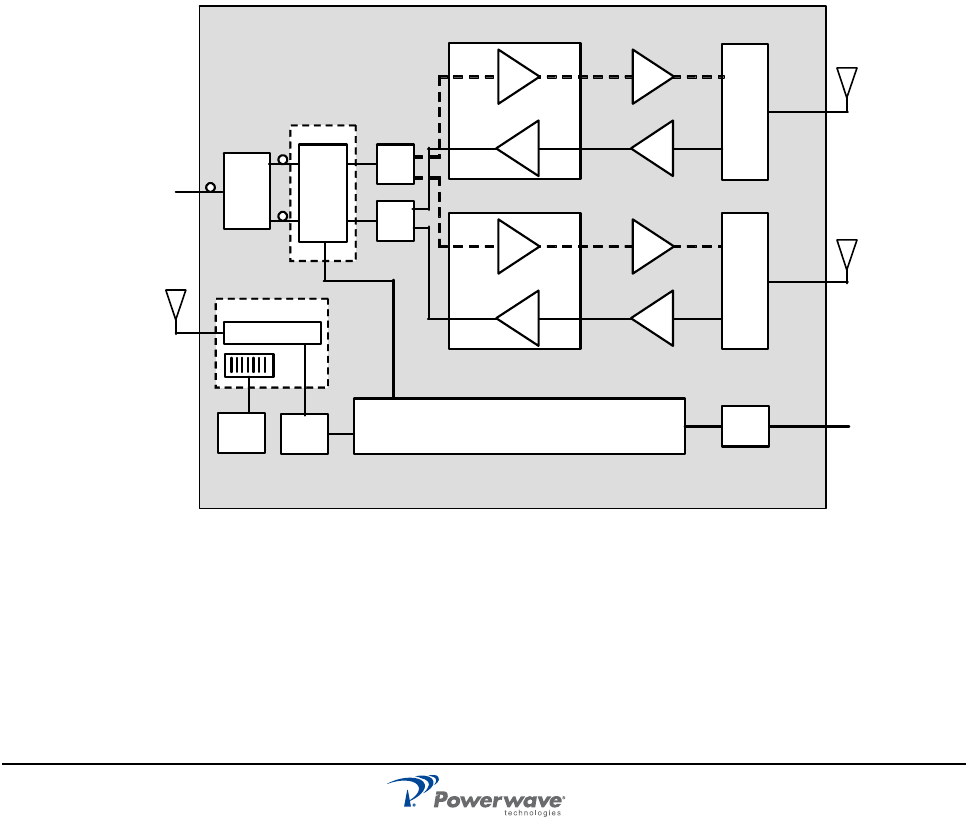
044-05251 Rev A A-1
Appendix A
Block Diagrams
Introduction
This appendix describes the main signals paths for the WRH.
Non-Diversity
Figure A-2 shows the non-diversity block diagram configuration of the WRH-V. The WRH-V is always fed by a
BTS via either a BMU or an OCM. The TX signal from the BTS is converted to an optical signal in a BMU or
OCM and fed to the WRH-V via a fiber optic cable. The optical signal is then received by the FON and
converted to an RF signal. The FON supervises the signaling and reports errors via the RCU connected to the
CU.
The RF signal enters the WBA, is amplified, and further amplified in amplifier stages followed by controllable
attenuators. The signal exits the WBA and enters the MCPA where it is amplified and fed to the DPX. The
amplified output signal passes the DPX before it is fed to the service antenna.
The uplink signal path is located on the same WBA but goes through an LNA before entering the WBA.
Figure A-1 WRH-V Block Diagram - Non-Diversity
WDM
FOU
DX
DX
DPX
DPX
WBA
WBA
DL
DL
UL
UL LNA
LNA
MCPA
MCPA
To/From
OCM or
BMU
RCU
RCI
PSU CU
FON
ALI To
External
alarms
850 MHz
TX0/RX0
1900 MHz
TX0/RX0
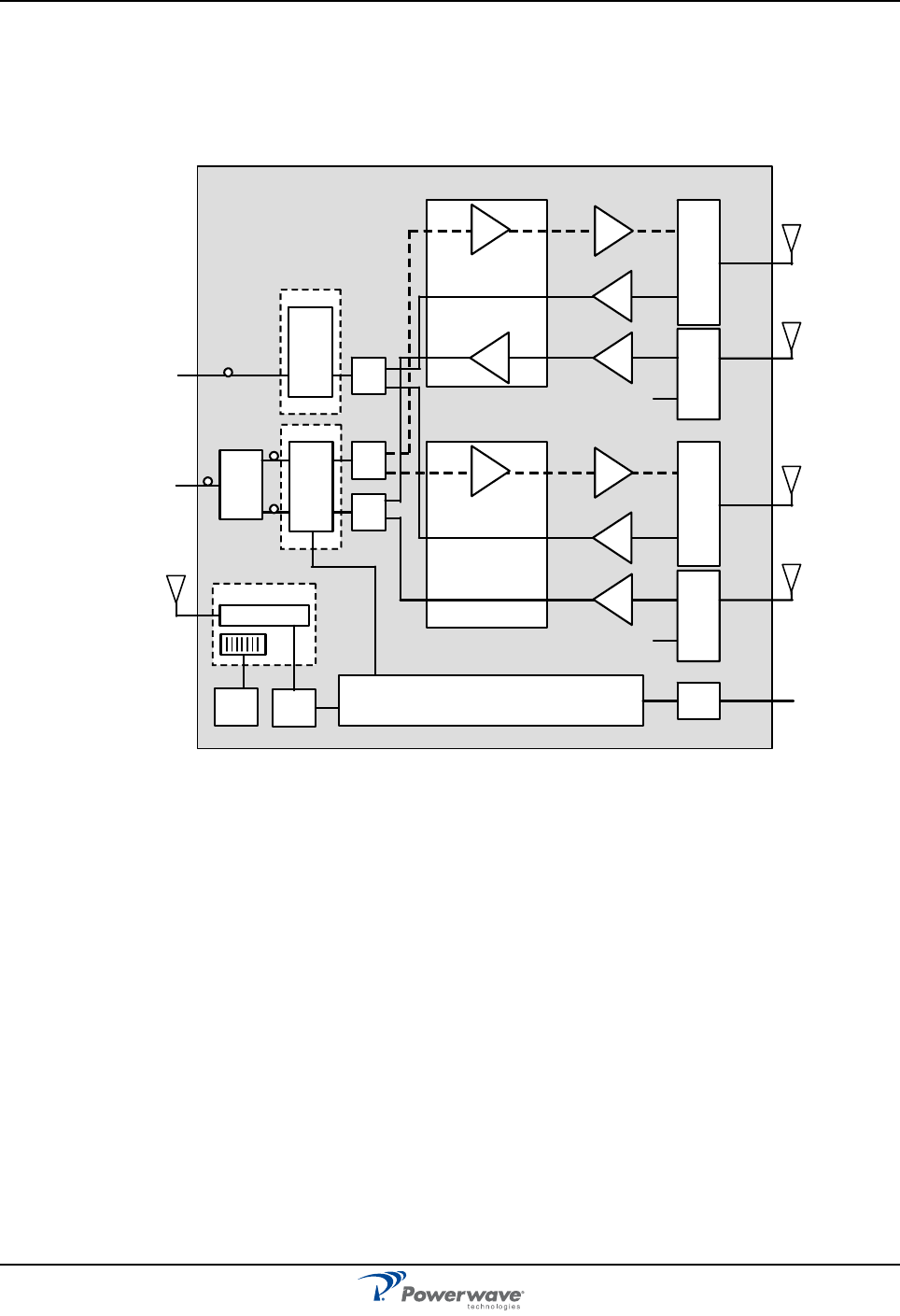
Diversity High Power Wideband Radio Head (WRH-V)
A-2 044-05251 Rev A
Diversity
Figure A-2 illustrates the diversity block diagram configuration of the WRH-V. With diversity installed, there
are two paths on the UL instead of one. This requires an additional FON for the added receive path signal.
Signal flow is identical to the non-diversity version with the MCPA on the DL and LNAs on the UL providing
the additional amplification out of and into the WBA.
Figure A-2 WRH-V Block Diagram - Diversity
WDM
DX
DX DPX
WBA
DL
LNA
MCPA
To/From
OCM or
BMU
RCU
RCI
PSU CU
FON
ALI To
External
alarms
FOU
DX
LNA
DPX
DPX
WBA
LNA
MCPA
LNA
DPX
UL
DL
FON
1900 MHz
TX0/RX0
850 MHz
TX0/RX0
850 MHz
RX1
1900 MHz
RX1